Lawsuit by U. undergraduate alleges Brown mishandled Title IX complaint
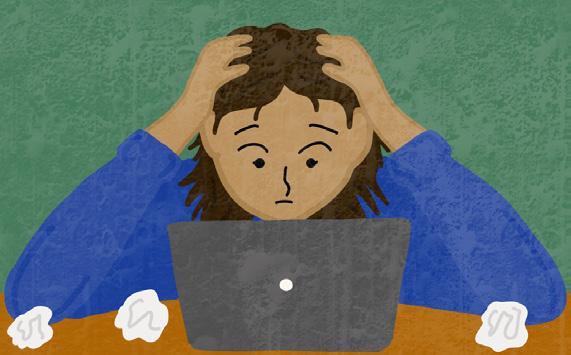 BY SAMANTHA CHAMBERS, NEIL MEHTA AND JULIA VAZ SENIOR STAFF WRITER & UNIVERSITY NEWS EDITORS
BY SAMANTHA CHAMBERS, NEIL MEHTA AND JULIA VAZ SENIOR STAFF WRITER & UNIVERSITY NEWS EDITORS
A lawsuit filed Monday both alleged that Brown violated the law in mishandling a Title IX case and accused a former Brown men’s lacrosse player — who has since graduated — of raping a student in October 2021.
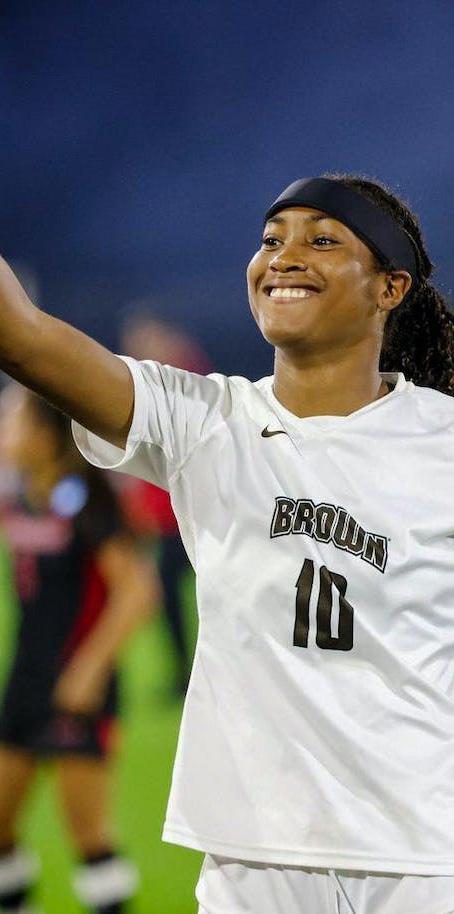
The plaintiff, a Brown undergraduate identified by the pseudonym Jane Doe, alleges Brown failed “to comply with the law in connection with its mishandling of and retaliation against” her Title IX complaint following the alleged assault, according to the lawsuit. The Herald reviewed the lawsuit filing before the court sealed the complaint after Monday evening.
The lawsuit also names the former lacrosse player as a defendant. It alleges he sexually assaulted the plaintiff, caus-
STUDENT GOVERNMENT
Clubs face slashed budgets
UFB’s
 BY KATHY WANG UNIVERSITY NEWS EDITOR
BY KATHY WANG UNIVERSITY NEWS EDITOR
The University’s Undergraduate Finance Board faced a $1.5 million gap between the funding requested by student groups and the money it could disperse to them this year, UFB President Arjun Krishna Chopra ’25 told The Herald. UFB, the student government branch that allocates student group funding, spent aggressively last academic year in an effort to distribute the vast majority of their $1.2 million surplus, according to Chopra. But that spending, which ended up exceeding projections, has created shortfalls this year, Chopra said — creating lower budgets for groups ranging from the University’s South Asian Students’ Association and The College Hill Independent to Brown Mock Trial and
the Class Coordinating Board.
According to Chopra, the student activity fee — a part of tuition that UFB distributes between clubs — has increased this year for the first time since the 2018-19 school year from $286 to $300 per year.
But this increase was not enough to maintain the level of funding UFB provided for student groups last year, he said.
A spent surplus
In 2020, UFB gained unprecedented access to and published all of its historical data regarding revenue and costs dating back to the 2008-09 academic year — which is still present on its website but lacks data from the 2020-21 academic year on.
According to the statement accompanying the data release, UFB’s budget mainly comes from two sources: the student activity fee collected from every
SEE UFB PAGE 9
ing her “severe physical and emotional harm.” The former lacrosse player is being represented by Ratcliffe Harten Galamaga LLP, a Providence firm. The firm did not respond to requests for comment.
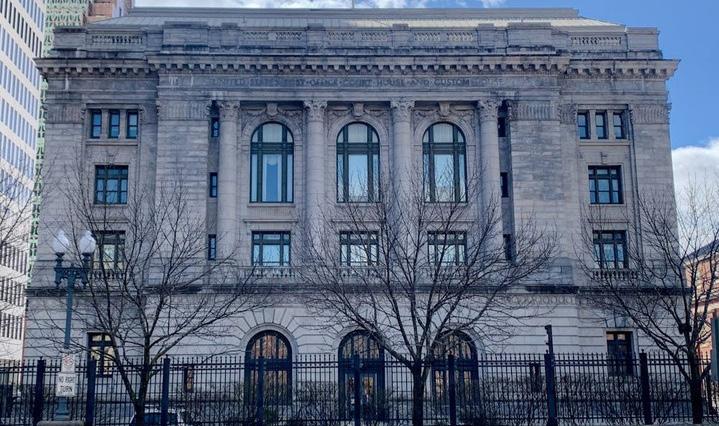
The lawsuit is one of several in recent years alleging the University has violated Title IX, which prohibits sex-based discrimination in educational programs that receive federal funding. The plaintiff is represented by Herman Law Group, a Providence firm, as well as the New York law firm Grant & Eisenhofer P.A., which represents the plaintiffs in a different Title IX lawsuit originally filed in August 2021 as a class-action suit that alleged Brown neglected to protect students from sexual harassment and prevented the harassment
from being reported. As of August, the case, now severed into multiple separate cases, was approaching discovery.
“What we allege is a systemic mishandling of Title IX cases,” Irene Lax, one of the attorneys representing Doe, told The Herald. “With respect to each of those lawsuits, we believe strongly in the strength of these allegations,” added Cindy Morgan, another attorney for the plaintiff.
The Title IX Office and the University’s athletics department directed requests for comment to University Spokesperson Brian Clark, who wrote in an email to The Herald that the University “dispute(s) the plaintiff’s claims against Brown.”
SEE LAWSUIT PAGE 14
Simmons discusses life, career after Brown tenure
Simmons details journey since 2012, committment to education, service
BY NATALIE VILLACRES SENIOR STAFF WRITERAdored, disarming and dedicated. When asked about former University President Ruth J. Simmons, her peers were far from speechless. But despite her admirable career and undeniable popularity, they all agree that she falls short in one crucial area.
“Everybody tells me that I have absolutely failed at retirement. And I have to confess — that’s true,” Simmons said lightheartedly.
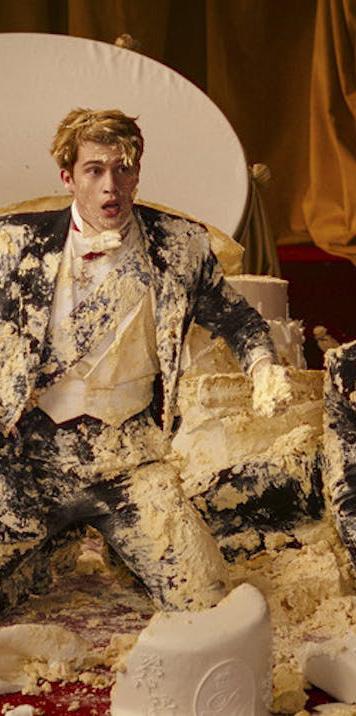
Since stepping down as president of the University in 2012, Simmons has held a number of roles in the time since, forming countless relationships and making lasting impacts across the country. Last
semester, she spoke with The Herald about her journey from Brown to today, offering an inside look into her most recent endeavors.
Back to Houston
After completing her term over a decade ago and welcoming former Princeton colleague Christina Paxson P’19 P’MD’20 to the University, Simmons returned to her home city of Houston to take time off post-Brown. Yet according to Simmons, the phone simply did not stop ringing.
“When I stepped down from Brown, my intent was actually to retire and not have a full-time position,” Simmons said. “It’s just that when matters arise that are important to me and consistent with the values that I’ve had over my career, it’s very hard for me to turn away from them.”
SEE PRESIDENT PAGE 16
$2.1M revenue not enough to met $3.6M in student group requestsKAIOLENA TACAZON / HERALD
WEEK IN HIGHER ED:

WEEK IN PROVIDENCE:
Rhode Island hit with heavy flooding, hurricane preparations
Over the past week, thunderstorms and heavy rain have pummeled the Ocean State, canceling events, closing roads and damaging homes.
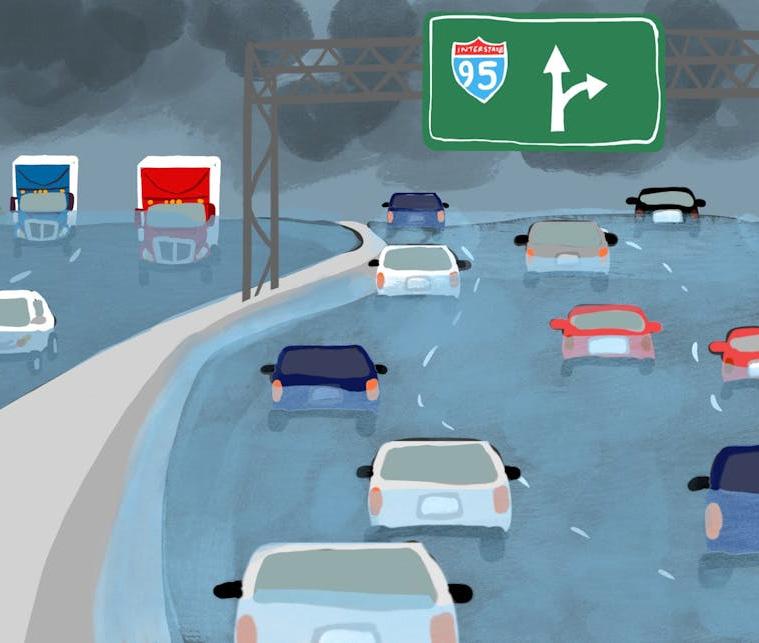
1
Buyer of human remains stolen from Harvard Medical School morgue pleads guilty
Jeremy L. Pauley, from Pennsylvania, admitted that he knowingly purchased stolen body parts and resold many of the remains to others. He now faces up to 15 years in prison.
Tornado ‘likely’ touches down in Rhode Island, Connecticut
Around 4:30 p.m., University students heard a siren blaring throughout campus as a tornado warning reached Providence County over the next 45 minutes.
As of press time, the National Weather Service’s Boston outpost reported that it was “likely” a tornado occurred, though its strength was not yet known.
Government officials are bracing for more severe weather with Hurricane Lee expected to make landfall on the Eastern Seaboard this weekend. Officials are advising Rhode Islanders to stay away from the shoreline with dangerous surf expected.
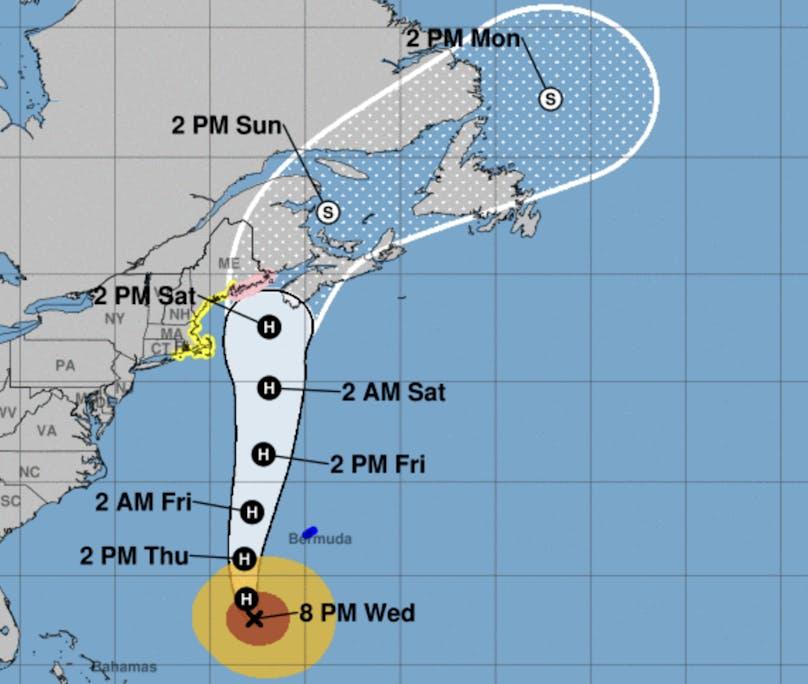
2
One of the largest private universities in the U.S., with an endowment of over $5 billion, announced steps to address the climate crisis after years of student protest.

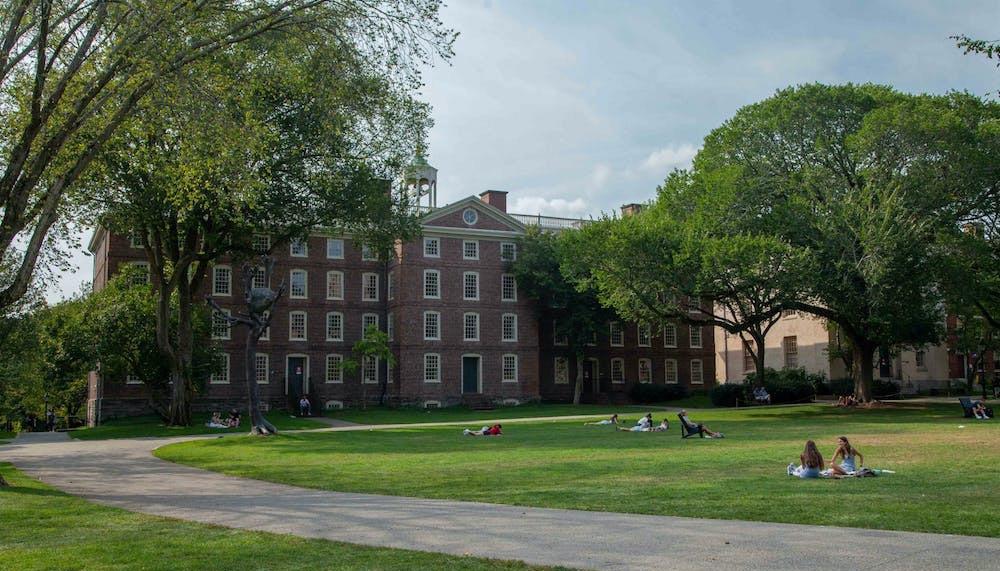
New York University will divest from fossil fuels in win for student activists 3 Trinity College commits to fossil fuel divestment by 2030
Trinity College (Canada) announced that it would fully divest its endowment from fossil fuel companies by 2030 or sooner. The announcement comes shortly after the University of Toronto’s two other federated colleges committed to divest.
Rain, lightning disrupt second day of PVDFest
PVDFest’s second day was delayed by 90 minutes and ended three hours early Saturday due to rain and lightning. Providence Mayor Brett Smiley said that vendors — who paid to attend — may be compensated for the shortened length of the festival.
“I am really empathetic to the damage done to businesses and we’re working to see what resources might be available,” he told WPRI-12.
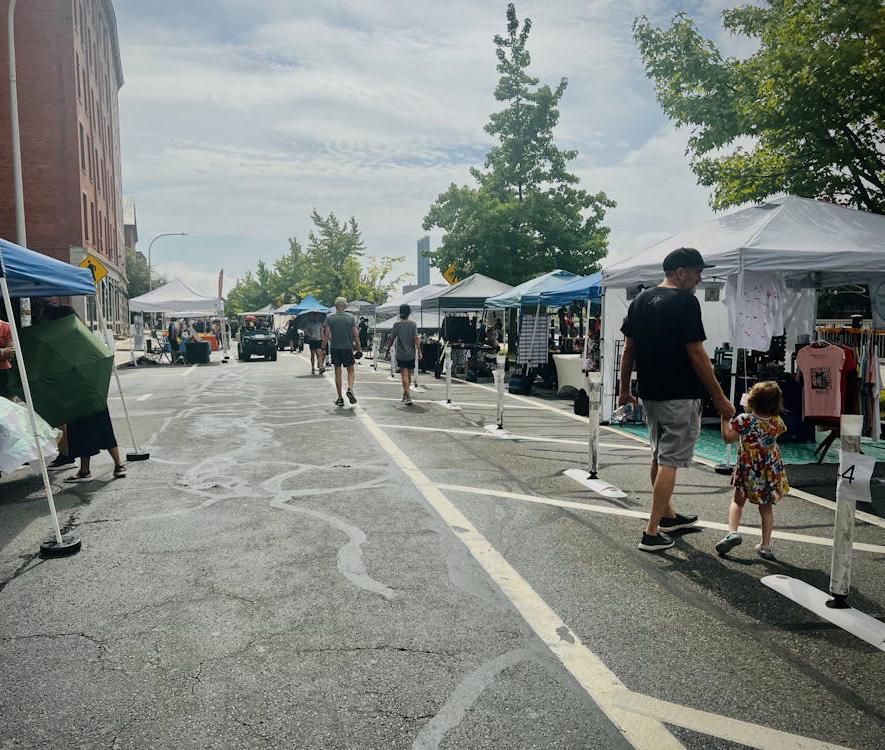
THIS WEEKEND
UNDERGRADUATE STUDENT LIFE
Health Services announces access to free emergency contraception
wrote in an email to The Herald.
BY ANIYAH NELSON UNIVERSITY NEWS EDITORHealth Services is now offering free, over-the-counter emergency contraception at the on-campus pharmacy, according to a Sept. 7 Today@Brown announcement to the University community.
Health Services has offered both emergency and prescription contraceptive options for over a decade, ranging from birth control pills to intrauterine devices, Vanessa Britto MSc’96, the associate vice president
Brown has also offered safe sex supplies such as condoms and lubricant for over a decade, she added. But students previously had to pay out-ofpocket or bill the charges to insurance to access such products.
With this recent change, all Brown undergraduate, graduate and medical students are able to access these resources for free and without a prescription or health insurance coverage.
While discussions surrounding this initiative began before the pandemic, a working group of medical providers, the University pharmacist,
dents” and second to increase access to information about sexual health options and resources at the University, Britto wrote.
monique jonath ’24, who works as a sexual health advocate and student coordinator for the Sexual Health Awareness Group, also cited equity as an important consideration for making sexual health resources accessible.
“Condoms in stores are expensive, (and) appointments for various types of contraceptives can be expensive, especially with co-pays,” jonath said. “If you can easily get something, it just makes it feel a lot less daunting.”
know “that you can get pregnancy testing for free at the pharmacy (or) that you can go in for an appointment to get a consultation about long-acting reversible contraceptives,” jonath said.
jonath hopes that Health Services’ decision to expand access to contraceptives will also improve community-based forms of care, noting that people who feel vulnerable in discussions concerning sexual health might be more comfortable relying on direct community resources.
Health Services also plans to offer pop-up events throughout the fall that will allow students to collect free safer
Health Services providers, according to Britto. jonath emphasized the importance of this move considering broader national trends, such as the Supreme Court’s decision to overturn Roe v. Wade in June 2022. Access “can be extremely helpful for folks (trying to) keep themselves safe from the robbing of personal autonomy that we’re seeing in so much of the country,” they said. “If other universities were to adopt this approach and be very firm on the fact that they want contraceptive access and health empowerment tools to be ble, I’m hoping ally shift
SINCE 1891
THE BROWN DAILY HERALD
133RD
Sandlow
Kathy Wang
Aniyah Nelson
Katie Jain
DIGITAL NEWS Director of Technology
Swetabh Changkakoti
COMMENTARY
Editorial Page Editors
Kate Waisel
Devan Paul
Head Opinions Editor
Alissa Simon
Opinions Editors

Juliet Fang
Yael Wellisch
Anika Bahl
MULTIMEDIA

Photo Chiefs
Elsa Choi-Hausman
Claire Diepenbrock
Photo Editors
Mathieu Greco
Lilly Nguyen
Kaiolena Tacazon
Social Media Chief
Sahil Balani
Podcast Editors
Finn Kirkpatrick
Jacob Smollen
PRODUCTION
Copy Desk Chief
Brendan McMahon
Design Chief
Neil Mehta
Design Editors
Ashley Guo
Gray Martens
Designers
Joyce Gao
Menasha Leport
Tom Li
Nathaniel Scott
Tiffany Tran
Jane Zhou
BUSINESS
General Managers
Joe Belfield
Andrew Willwerth
Sales Director
Alexander Zhou
Finance Director
Eli Pullaro
Submissions: The Brown Daily Herald publishes submissions in the form of op-eds and letters to the Op-eds are typically between 600 and 900 words and advance a clear argument related to a topic of campus discourse. You can submit op-eds to opinions@browndailyherald.com.
Letters to the editor should be around 250 words and respond to an article or column that has appeared in The Herald, or critique or commend The Herald’s editorial decisions. You can submit letters to the editor to letters@browndailyherald.com.
Submissions undergo multiple rounds of editing. These rounds of editing generally take place over the course of one evening, and you may have to respond to edits late in the evening. If you know you will be unable to do so, please mention that in your email, and we will do our best to work with you.
Submissions can build on reporting from The Herald, reporting elsewhere, official statements from the University or other groups and other reputable sources, but they cannot break news or contain information that The Herald cannot verify. Because we cannot publish unsubstantiated information, failure to provide appropriate sources may mean we have to modify or remove unverified claims.
The Herald will not publish anonymous submissions or submissions authored by organizations. Leaders of student organizations can be identified as such but cannot write under the byline of their organization.
The Herald cannot publish all submissions it receives and reserves the right to edit all submissions.
All submissions to The Herald cannot have been previously published elsewhere (in print or online — including personal blogs and social media) and must be exclusive to The Herald. Once your submission is published in The Herald, The Brown Daily Herald, Inc. owns the copyright to the materials.
Commentary: The editorial is the majority opinion of the editorial page board of The Brown Daily Herald. The editorial viewpoint does not necessarily reflect the views of The Brown Daily Herald, Inc. Columns, letters and comics reflect the opinions of their authors only.
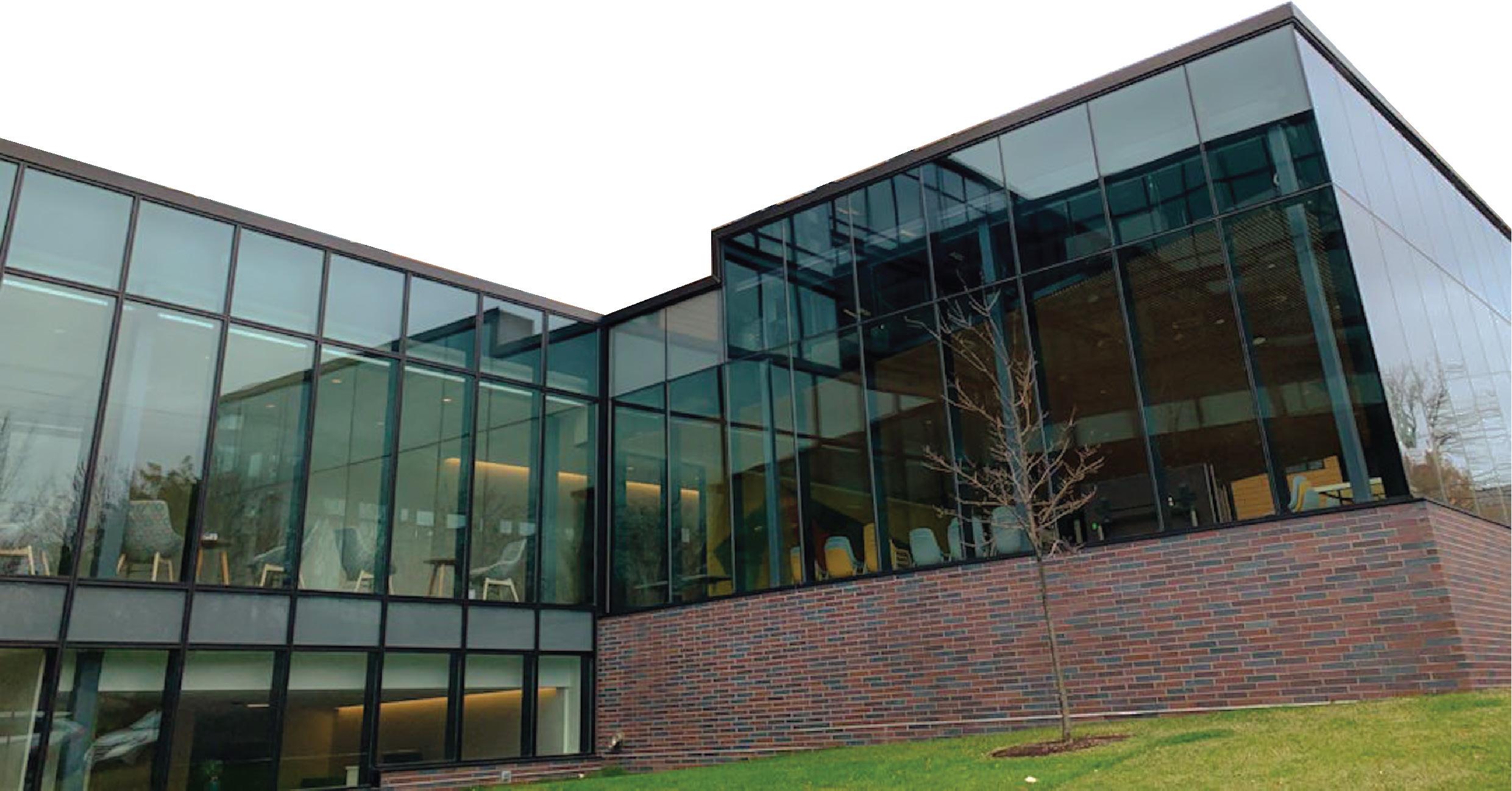
Corrections: The Brown Daily Herald is committed to providing the Brown University community with the most accurate information possible. Corrections may be submitted up to seven calendar days after publication. Periodicals postage paid at Providence, R.I. Postmaster: Please send corrections to P.O. Box 2538, Providence, RI 02906.
Advertising: The Brown Daily Herald, Inc. reserves the right to accept or decline any advertisement at its discretion.
reserved.
PVDFest returns in full swing, unites community
Arts festival brings together vendors, performers, residents to build community
BY AVANI GHOSH SENIOR STAFF WRITERThis past weekend, the City of Providence hosted PVDFest in collaboration with the Department of Art, Culture and Tourism and FirstWorks, a non-profit organization. The festival had performers, vendors and other events across three days at the 195 District Park.
According to Gregory Waksmulski, the festival volunteer coordinator, PVDFest is “the city’s premier arts festival that brings together performing artists, teaching artists and art activists from the local area.”
Previously held in downtown Providence, the festival moved to 195 District Park this year, which allowed the festival team to engage with more artists, particularly those in the Jewelry District who had not participated in previous years.
“Not only was it already a big beast, but now this year we’re now playing with other organizations and groups,” Waksmulski said. Nonetheless, “it’s a chance to exercise those muscles of coalition building and cooperation.”
Representation and diversity in art
The “I-195 (highway) cut the city into several pieces and actually split historically Black, Indigenous and people of color neighborhoods,” Waksmulski said. He hopes that PVDFest can serve as a “transformative moment” for community members and downtown businesses to “rebridge the neighborhoods with the downtown area.”
Waksmulski said that PVDFest organizers worked with Haus of Codec — an organization that provides “a safe housing space” for youth and connects with queer and BIPOC artists through its art markets — to encourage vendors from historically underprivileged backgrounds to participate.
Haus of Codec Operations Director Gem Marley said that the organization got involved with PVDFest after its founder Julio E. Berroa served as the parade manager for the festival.
According to Marley, Haus of Codec started hosting art markets in 2021 to connect with underrepresented artists while finding support to open emergency shelters and transitional housing for people between the ages of 18 and 24.
B McCray, owner of the small jewelry business BwitchedByB, was a vendor at PVDFest and got involved through Haus of Codec. They had been at multiple Haus of Codec events before and thought the event would be a good way to reach out to more of the community.
Kristen Angelo, owner of ceramic
shop Rainbow Home Studios, spent this year’s PVDFest as a vendor — a change from her previous participation in the festival as a clarinetist for street band Extraordinary Rendition. Angelo said that she wanted to engage with the Providence community and its unique culture.
Connecting after a pandemic
During the COVID-19 pandemic, PVDFest adapted to a virtual gathering which Waksmulski said did not quite foster the same feeling of connectedness. Last year, PVDFest made its physical return.
Shan Adria, a BwitchedByB employee, mentioned that PVDFest “started as a giant block party for all of the city’s locals … to get together and have a party during the summer.” But with increased safety and public health restrictions following the pandemic, the festival has not felt the same.
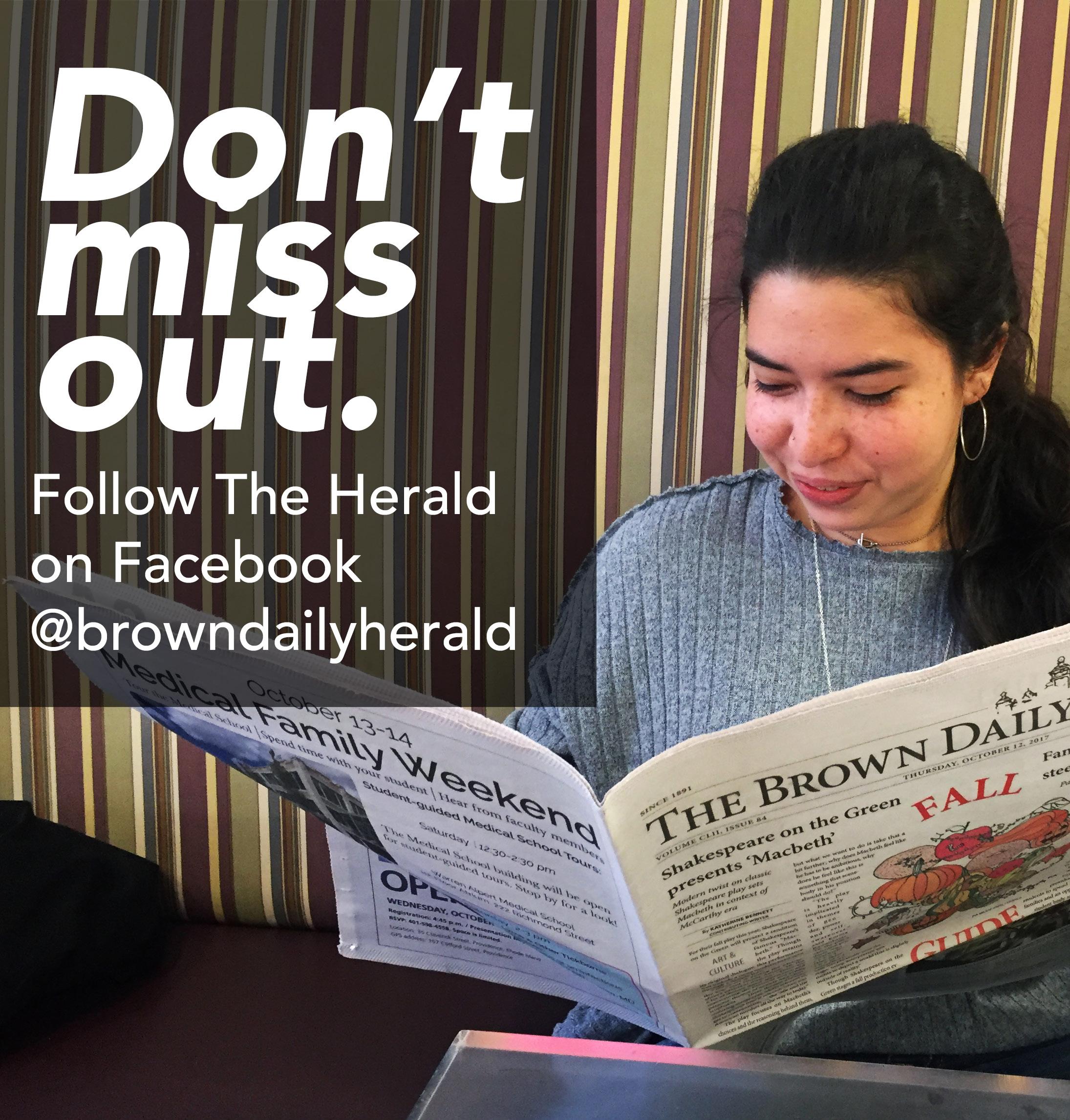
Angelo added that moving the location of PVDFest contributed to some of the disconnect community members felt post-pandemic. “Anytime you’re moving (an event) to the East Side … it’s going to make (attending) more accessible and easier to one certain demographic” while being more inaccessible for other residents.
The location change is one of a set of controversial changes to PVDFest that Mayor Brett Smiley announced in June, along with banning open containers of alcohol and allowing block parties on only one of the three nights.
Nonetheless, Waksmulski believes this year’s PVDFest was still well-attended. “People were hungry for it again,” he said. “The hunger persists even when we move the location slightly, and even when it’s thunderstorming, our headliners both nights have packed the park.”
Hopes for the future
Marley said they hope vendors at PVDFest “get the exposure that they need to be able to support themselves through their craft… (and) that people come and appreciate the work that they do.”
McCray hopes that the unique style and personality of each performer, vendor and their items encourages more event go-ers to fully express themselves. “PVDFest is genuinely just about partying with everybody … and Providence is nothing but a bunch of unique people,” they said.
“It’s just an amazing chance to see performers from all over,” Angelo said. In the future, she hopes PVDFest becomes “a more centralized opportunity to see diverse acts and culture in one space.”
Waksmulski hopes the event continues to transform Providence “into a giant stage where we can all entertain each other and bring joy to the community” and carries on its title of “the community’s festival.”
No decision on voluntary payment agreements at finance committee meeting
Committee motions to continue meeting later, hold public hearing
BY RHEA RASQUINHA METRO EDITORThe Providence City Council Committee on Finance did not vote on two proposed voluntary payment agreements between the city and four private higher education institutions at a committee meeting Tuesday evening. The meeting will be continued at a later date, with a public hearing scheduled for Sept. 26.
The proposed agreements were announced Sept. 5, with a memorandum of understanding between the city and four private colleges and universities — Brown, Johnson and Wales University, Providence College and the Rhode Island School of Design — and a memorandum of agreement between only Brown and the city, The Herald previously reported. At the meeting, the Finance Committee heard from members of Mayor Brett Smiley’s administration about the proposals.
Providence Chief Operating Officer Courtney Hawkins presented details of the proposed MOU and MOA. Alongside City Solicitor Jeff Dana and Chief Financial Officer Lawrence Mancini, she then fielded questions from the Finance Committee and other attendees. According to Hawkins, the voluntary payments of the proposed new agreements are more than double the payments of the city’s previous voluntary payment agreements, signed in 2003 and 2012.
Hawkins detailed three key priori -
ties of the city during the negotiation process: ensuring that institutions provided significantly more financial support to Providence over the term of the agreement, setting a new model for agreements between institutions and cities surrounding voluntary payments and respecting the economic challenges and priorities of institutional partners.
Attendees raised concerns about the time frame of the agreement restricting future administrations — as well as provisions regarding property acquisition and zoning.
One of the administration’s goals in creating a 20-year agreement was to try to “set up future administrations with guaranteed funding,” Hawkins said. Additionally, the street acquisitions by Brown included in the MOA — one block on College Hill and four blocks in the Jewelry District — would need to go through the City Council and City Plan Commission and are not guaranteed under the agreement, she added.
“Any plans will go through appropriate city processes and consultation with the neighborhood,” said Executive Vice President of Planning and Policy Russell Carey ’91 MA’06.
According to Carey, although a 2012 MOA between the University and Providence also included property acquisition by the University, only one of the three blocks — Olive Street — became a private road. The other two remained public streets.
Two blocks on Richmond Street between Ship and South streets — one of the three proposed acquisitions in the new agreement — are adjacent to the University’s planned integrated life sciences building in the Jewelry
District. The area will need to close at least temporarily due to construction, Carey said. If their acquisition is approved, the University hopes to make the space a public green space, given the lack of such spaces in the Jewelry District, he added. Plans for the other two blocks in the Jewelry District have not yet been developed.
“I think this has been a very robust process, and I think this agreement is incredibly positive for the city,” said Councilor John Goncalves ’13 MA’15. But he expressed concern about the proposed extension of the I-2 Zone, which offers special zoning for educational institutional districts, under the MOA, citing neighborhood concerns regarding the Brook Street dorms that were “rejected” by the University, though the University did decrease the height and scale of the projects after community feedback.
Both Councilors Shelley Peterson and Miguel Sanchez voiced concerns about “binding future councils” to the agreements. “Not being able to advocate for more financial contributions (from institutions)” is “not fair to the residents of the community,” Peterson said.
In response, Dana described the nature of the agreements in requiring shared understanding between parties, adding that if payments from the colleges stop, the city is likewise not required to fulfill its obligations.
Peterson also expressed concern about the potential loss of tax revenue due to the sale of city property to institutions, particularly without a system of transitional payments as under the 2003 MOU, and proposed adding another transitional payment clause.
Looking back at Rhode Island’s 2023 legislative session
Reproductive
BY YAEL SARIG SENIOR STAFF WRITERAlmost 2,700 bills were introduced in the Rhode Island General Assembly in the 2023 session, which runs from January to June, but the vast majority never saw the floor.
The Herald reviewed several of the most important bills passed during the legislative session — and the bills that didn’t pass, offering a preview of what Rhode Islanders can expect from legislators in 2024.
Housing package
Housing took center stage in the legislature last spring, with the vast majority of House Speaker K. Joseph Shekarchi’s (D-Warwick) 14-bill package to address the state’s housing crisis passing.
13 of the 14 bills ultimately passed, including legislation to repurpose abandoned or unused school buildings for affordable housing, simplify the approval process for the construction of low and moderate-income housing and eliminate rental application fees.
“Real change is never easy, but these bills will help to create more affordable housing that is so desperately needed in Rhode Island,” Shekarchi said in a May press release.
Lead pipe replacement
Attacking a problem affecting an estimated 29,000 drinking water service lines in Rhode
PROVIDENCE
Island, this bill mandates the replacement of lead pipes across the state within the next 10 years, “contingent upon available funding.” Additionally, the bill requires lead risk assessments to be performed on all houses built prior to 2011, instead of the current cutoff of 1978.
Senate President Dominick Ruggerio (D-North Providence) wrote in an email to The Herald that the legislation was a “top priority” for both him and the Senate, citing potential harmful effects of lead exposure such as slowed growth and learning problems in children.
“This is an environmental issue, an education issue, a finance issue and, most importantly, a public health issue, and it required collaboration across many areas of expertise to bring this program to fruition,” he wrote.
Ruggerio anticipates that appropriating funding to be the greatest challenge to the bill.
While over $140 million in federal funding is available to support the project, Ruggerio does “not expect existing funding to be sufficient.”
Still, he emphasized that funding the lead pipe replacement project will continue to be a state priority, even if federal funding is depleted.
Equality in Abortion Coverage Act
The Equality in Abortion Coverage Act ensures that individuals on Medicaid and state employees will receive insurance coverage for abortion procedures. The contentious bill, which had been introduced every year since 2020, passed the state House in a 49-24 vote, the fourth attempt to pass the bill. The legislation builds on the Reproductive Privacy Act, which codified Roe v. Wade’s protections of
abortion rights into state law in 2019.
Roughly one-quarter of the state’s population are Medicaid recipients, and 30,000 residents are on state employee insurance plans, according to a General Assembly press release. Prior to the passage of the EACA, these individuals would have needed to pay the full cost of any abortion procedures out of pocket.
Majority Whip Katherine S. Kazarian (D-East Providence) previously said the EACA is “not about re-debating the question of choice” but rather about ensuring equal healthcare coverage for all individuals, regardless of their insurance plan.
Wage theft
In June, Gov. Dan McKee signed into law a bill that would change wage theft from a misdemeanor into a felony. The law defines wage theft as occurring when an employer intentionally fails to pay an employee more than $1,500 in wages, a crime which now carries a penalty of up to three years in prison in addition to fines.
The bill, sponsored by state Sen. Meghan Kallman (D-Pawtucket) and by state Rep. Robert E. Craven (D-North Kingstown), will protect workers from various offenses like being paid less than minimum wage or not being compensated for working overtime.
“When the powerless steal, they are punished,” Kallman said in a press release. “But when the powerful knowingly steal from hardworking Rhode Islanders, they are getting away with it.”
Assault weapons ban
A proposed assault weapons ban, introduced by state Rep. Jason Knight (D-Barrington, Warren), would have banned “the possession, sale and transfer of assault weapons.” The bill never made it out of committee.
Knight said he plans to continue lobbying for the bill and reintroduce it next legislative session by “doing what we’ve always done, which is to talk to people who are opponents and try to figure out what their opposition is and see if we can make any adjustments,” Knight said.
House Minority Whip David Place (R-Burrillville, Glocester), who was opposed to the legislation, said he was “shocked that some variation of firearms legislation did not pass.”
Free meals
In an effort to address growing food insecurity in Rhode Island, lawmakers proposed to use state funds to offer all public school students free breakfast and lunch. But the two bills creating free meals only passed the state Senate, not the House.
Concerns regarding the program included its $40 million cost. Shekarchi said the program costs wouldn’t have been covered by McKee’s budget.
“I am working with Governor McKee, as well as Rep. Justine Caldwell, the House sponsor, to attempt to achieve an affordable solution for next year’s session,” Shekarchi told the Providence Journal in August.
In 2022, food insecurity in Rhode Island households reached 31% according to The Rhode Island Community Food Bank, a sig-
nificant jump since the onset of the COVID-19 pandemic.
Looking forward
Knight said the General Assembly “passed a lot of good legislation this year,” citing the EACA and the housing package. Next session, he hopes to focus on environmental issues and the reintroduction of gun control legislation. Place added that he was pleased by the willingness of the two parties in the legislative body to work together.
“The best tell … for the session was the fact that the three senior Republicans in the caucus all did, in the end, vote for the budget,” Place said. He added that his priority in the coming year is to ensure that “no violations of the Second Amendment to the Constitution are passed.”
But the 2024 legislative session may present legislators with new difficulties. Ruggerio wrote that dwindling federal funds, which were largely allocated to the state in 2020 and 2021 from federal COVID-19 relief packages, will present the state with a more challenging budget process than it has faced in several years.
Ruggerio added that he expects the state Senate to prioritize reforming the Law Enforcement Officer’s Bill of Rights, which protects law enforcement officers from prosecution arising from actions taken during the performance of their official duties. Ruggerio said “a sensible version” passed the Senate, “but late in the session.” The state House did not take up the bill.
The Senate will also prioritize the continued expansion of access to child care and pre-kindergarten, Ruggerio said.
Community celebrates new Edward Mitchell Bannister statue
Art Project leaders, officials discuss impacts of project, hopes for future
BY RHEA RASQUINHA METRO EDITORCelebrations for the new statue of painter Edward Mitchell Bannister continued Sunday despite the afternoon’s thunderstorms and the movement of the unveiling ceremony from Market Square to the RISD Museum auditorium.
Edward Bannister won the top prize at the 1876 Philadelphia Centennial Exposition, along with several other prizes at art exhibitions throughout the northeast, and was a co-founder of the Providence Art Club. His wife, Christiana Carteux Bannister, was an entrepreneur and abolitionist who founded the “Home for Aged Colored Women,” which continues operations as the Bannister Center for Rehabilitation and Nursing today, The Herald previously reported.
The ceremony and statue are the work of sculptor Gage Prentiss and the Bannister Community Art Project, which was established after Prentiss presented the idea of a community-oriented piece to the Art Club, said Project Co-Chair Nancy Gaucher-Thomas. Prentiss was previously commissioned to create a bust of Edward Bannister, which was then donated to the Art Club, she added.
Gaucher-Thomas said that the project, which has been about two and a half years in the making, has been made possible by an initial grant from the Papitto Opportunity Connection as well as community donations.
Prentiss’ excitement over the project
stemmed from his experience at a show of Bannister’s work in 2018. Prentiss said he felt a “warmth” watching people viewing Bannister’s paintings, which he wanted to convey in his piece.
Prentiss drew inspiration from “a handful of images and lots of averages of anatomy” along with countless anecdotes about Bannister and his “confidence, ease, passion … and charisma,” he said. “He’s just a force.”
The design of the statue — Bannister sitting on a bench sketching — is meant to invite people to sit with him and participate in the art, Prentiss added.
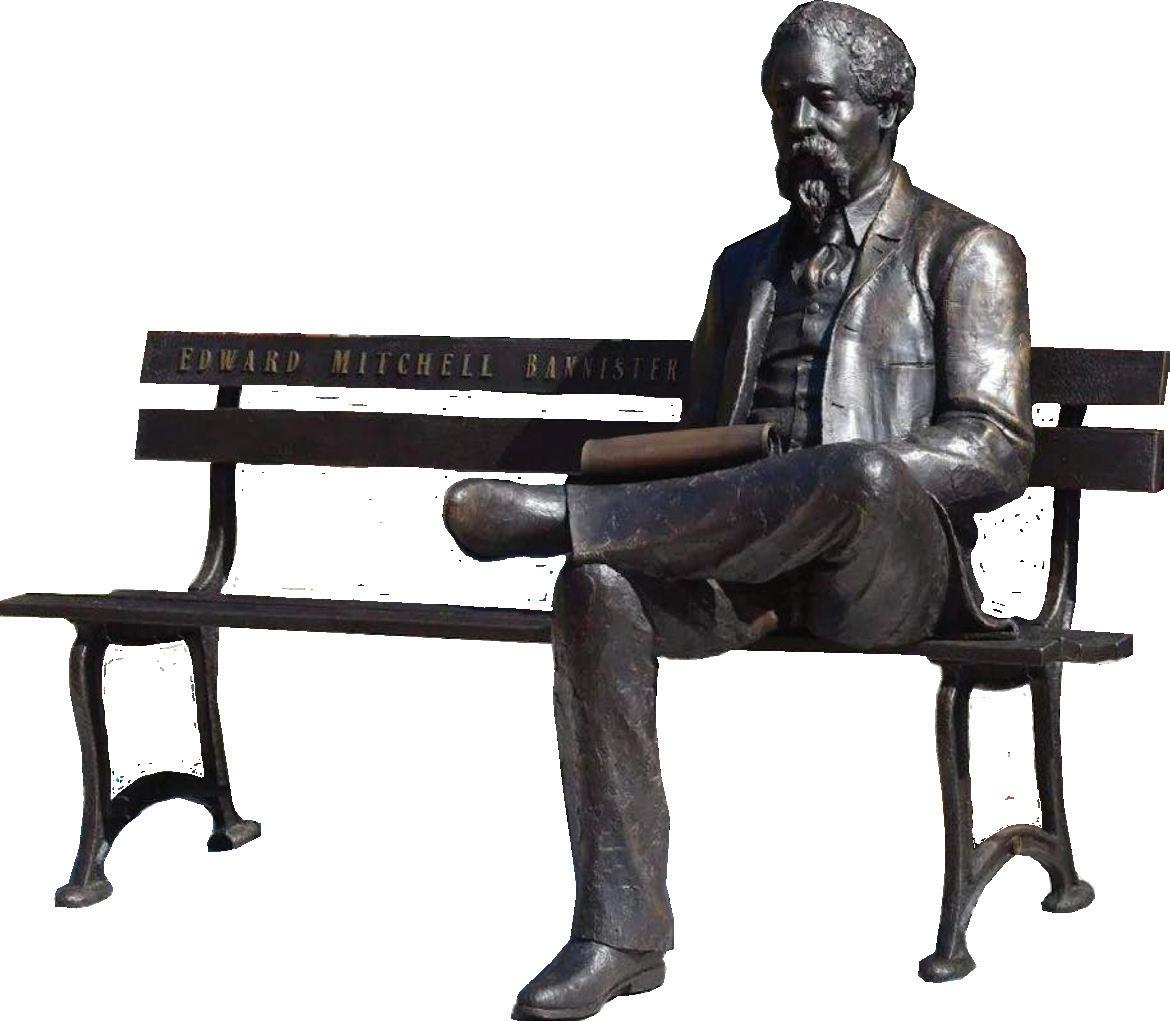
‘Getting past the storm’: Celebrations continue indoors
Following a cocktail party and block party on Friday and Saturday, Sunday’s unveiling ceremony included performances from Mixed Magic Theater Co-Founder Bernadet Pitts-Wiley and the Exult Choir.
Though the statue was not officially unveiled due to the weather, several city officials and project leaders still shared their remarks about the piece and the project’s impact.
“Bannister would have loved that there was a raging storm,” said Gaucher-Thomas, noting the sun breaking through stormy skies in some of his paintings that represent the perseverance of “getting past the storm and rebuilding our community.”
Senator Jack Reed and Mayor Brett Smiley discussed the importance of the arts to Providence and honoring the legacies of those who have contributed to the City. Smiley shared that the City just secured a grant “to evaluate com-
memorative works” in Providence and will be working to honor those whose contributions may not have previously been recognized.
Superintendent of Parks Wendy Nilsson said that the event was also “a celebration of public-private partnerships” and a project that “brings to light the significance of Market Square” in Providence’s history as a city center and site of many protests.
Rickman shared anecdotes from Edward Bannister’s life and urged those in the audience to support projects to uplift underrepresented and underserved communities.
To close the ceremony, Jennifer Davis-Allison ’73, BCAP’s other co-chair, discussed “the power of being supported” and reflected on the committee’s past two and a half years of work, describing them as “a state of learning.”
Davis-Allison encouraged the audience to think to the future and leverage Providence’s “vast art and cultural assets to facilitate equitable resourcing, access and credentialing.”
A collaborative effort
Davis-Allison found that community members quickly started to “carve out their own attachment” to the project, which seeks to engage “a diverse audience.”
“We have this magnificent sculpture, and, along with it, we have a community that has been connected around bringing this about,” Davis-Allison said.
BCAP has been a collaborative effort between the Art Club and other Providence leaders who are working to extend the project’s impact beyond the weekend’s festivities.
Stages of Freedom co-founders Ray Rickman and Robb Dimmick, who have been strong advocates for elevating the legacy of Edward Bannister and his wife, were also involved in the project’s advisory committee.
According to Dimmick, the project and statue represent “living history” and help expose community members to the Bannisters’ cultural and philanthropic accomplishments, which are “still so present and alive today.”.
Meanwhile, BCAP’s collaboration with the Downtown Providence Parks Network aims to support groups visiting the statue and engaging with the art, said Gaucher-Thomas.
Michael McGuigan, another project collaborator and teacher at Trinity Academy for the Performing Arts, put together a 400+ page bibliography on the Bannisters and worked on an integrated curriculum at the academy “to align art and history,” she added.
been about art in public space … (and) conversations about monuments and how (they) convey what we value,” said Gauch er-Thom as.
would like this (project) to be
a catalyst for many things,” including heightening “awareness around underrepresented communities and their youth,” said Davis-Allison.
The project has several plans beyond Sunday’s celebration, including a panel discussion in October, a community breakfast with Amos House and a day of service leading up to Edward Bannister’s birthday celebration on Nov. 2, Gaucher-Thomas said.
The project will also unveil a plaque in honor of Christiana Bannister on Oct. 8 at 10 a.m. at 10 Westminster St. and host a “Saving Bannister” talk about Edward Bannister’s paintings on Nov. 2 at 5 p.m. at the RISD Museum, Dimmick said.
Women’s soccer earns hard-fought draw with Saint Louis
Brittany Raphino ’23.5 continues early success in fifth and final season
BY NICHOLAS MILLER SENIOR STAFF WRITERThe three-time defending Ivy League champion Brown women’s soccer team is officially back in action. And that means All-American forward Brittany Raphino ’23.5 is back to scoring goals.
Raphino, who is taking advantage of the fifth year of eligibility she was granted by the Ivy League due to the pandemic, scored a late leveler Wednesday to help the Bears (3-1-1) earn a 1-1 draw against the Saint Louis University Billikens (4-2-1) at Stevenson-Pincince Field.
Bruno is ranked 23rd overall by Top Drawer Soccer, while Saint Louis is ranked 21st.
Raphino has picked up right where she left off in 2022 when she was named Ivy League offensive player of the year for the second-straight season. Tallying three goals and three assists already in the young season, Raphino now has 48 goal contributions in her Brown career.
“I want to put everything I can into this team,” Raphino said. “I love this program and that’s why I came back. I definitely feel my age for sure, but that’s given me a lot of confidence and allowed me to play my top game.”
With Raphino back alongside other key seniors, including her long-time attacking partner Ava Seelenfreund ’23.5, midfielders Sheyenne Allen ’23.5 and Evelyn Calhoon ’24, defender Jessica Hinton ’24 and goalkeeper Clare Gagne ’24, expectations for the Bears are high to begin the season.
Brown jumped out of the gates in August with a 6-0 win against SUNY Albany followed by a 4-3 comeback win against Central Connecticut State University, in which the Bears scored three
AQUATICS
unanswered goals in the match’s final 15 minutes.
A 1-0 loss to a red-hot Providence College, who have climbed up to No. 22 in the Top Drawer Soccer rankings, gave the Bears their first defeat, but a comfortable 2-0 victory over University of California San Diego got them back on track heading into their matchup against Saint Louis.
In the match against the Billikens, the Bears fell behind quickly thanks to a goal from Saint Louis’s Julia Simon just 90 seconds into the game. Billikens midfielder Jess Preusser received a throw-in in the penalty box and backed down Hinton before sending a looped cross near the penalty spot. A failed clearance from Calhoon landed at the foot of Simon, who fired a left-footed volley past Gagne.
The rest of the half was a stalemate with Brown attackers struggling to find space behind the Saint Louis defense. The Bears’ best chance came in the 30th minute when Raphino received the ball in the attacking area and turned her defender, setting up a two-on-one with Seelenfreund arriving on the right wing. Instead of passing, Raphino took a shot herself, which flew wide.
At the beginning of the second half, the Brown attack began to show the firepower fans have come to expect over recent seasons. Less than thirty seconds in, Seelenfreund played a through ball behind the Saint Louis defense for Raphino, who carried it into the right side of the penalty box and fired a low shot just barely saved by the foot of the Saint Louis keeper. Seelenfreund then got on the end of the ensuing throw-in, volleying it just wide.
Brown controlled play until Raphino finally got the Bears on the board with a breakaway goal that she has made her trademark throughout her career. Charging onto a ball sent over the top of the defense by midfielder Gianna De
Priest ’25, Raphino shrugged off her defender, took a deft touch around the onrushing Saint Louis goalie and calmly slotted the ball into the open net.
“I knew (De Priest) was going to pop it over the top, so I just knew it was a footrace and that I needed to beat the defender to the ball,” Raphino said. “When I was one-on-one with the goalie, it was just (about) taking a breath and taking my shot.”
Although in previous seasons Brown has featured a Raphino-Seelenfreund partnership in attack, the Bears used three forwards in the Saint Louis game, a change that saw Ra -
(defenders) dealing with (Seelenfreund) and (Maguire) out wide. It doesn’t really change what we do, it just gives us more options.”
“Our forwards are a big strength of our team so the more we can get them on the field, the more looks around goal, the more successful we’re going to be,” said Head Coach Kia McNeill.
After the equalizer, the Bears maintained the pressure, and in the 72nd minute, Raphino nearly gave Brown the lead. Picking up the ball in the midfield, Raphino paused before dribbling by her defender and unleashing a wicked shot from outside the box that the Saint
Men’s water polo excels in Bruno Classic
Center Ilias Stothart ’26 had a dominant performance during the game, scoring in every quarter to tally six goals total.
BY DENNIS CAREY SENIOR STAFF WRITERIt was a split start to the season for the men’s water polo team (3-2) last weekend. The Bears opened their season at the Katherine Moran Coleman Aquatics Center with five matches in the Bruno Classic. They emerged victorious against Augustana College, Bucknell University and no. 15 Fordham University, but were unable to win against no. 11 Pepperdine University and no. 6 University of the Pacific.
On Saturday, the Bears showcased an impressive offensive performance against Augustana. In the first quarter, Bruno outscored the Vikings 6-1 with goals from five separate players, including two from attacker Jaxson Tierney ’27.
After an even 3-3 second period, Brown opened the third quarter by netting five shots and allowing Augustana to score only once.
Later that day, the Bears took their first loss of the season to the 11th-ranked Pepperdine. Despite utility player Máté Tymcyna ’27 and attacker Gabe Chang ’25 scoring three goals each, Pepperdine trounced the Bears defense, which conceded 22 goals in the loss.
Down by only five at the end of the second period, the Bears were on the wrong end of a 7-1 rout in the third, which left them down 165. Bruno managed five goals in the fourth, but dropped the game 22-10.
“On that Pepperdine game, we learned that we’re not as good as we think we are if we don’t bring the energy, play humble, play grounded and stay true to ourselves,” said Head Coach Felix Mercado.
After splitting Saturday’s matchups, the Bears returned Sunday with a win against Bucknell. Chang led the Bears in scoring with three goals, followed by attacker Thomas Hoffmeister ’24 with two goals and two
assists.
The match was tight through the first two periods, but the Bears managed to dominate defensively from the first quarter onward: After allowing four goals in the first period, the Bears only conceded two more for the rest of the game, earning a 12-6 win.
Sunday night’s game against Fordham was the Bears’ highest-scoring performance of the weekend. After conceding six goals in the first period, the Bears mounted a sizable comeback, outscoring the Rams 17-7 in the last three periods.
“It makes us excited because we were able to achieve this with two weeks of practice and us being together with a lot of fresh faces,” said attacker Filip Aleksic ’24. “That made a lot of impact early on.”
The win was led by goalie Joe Gallagher ’24, whose 11 saves helped prevent Fordham from extending their early lead out of the Bears’ reach.
The Bears offense also dominated. Stothart scored five or more goals in one game for the second time during the Bruno Classic. Tymcyna netted
the ball far outside the penalty area, coasted through the Brown defense and found herself one-on-one with Gagne, who sprang off her line and stretched her left foot out to send Gaebe’s shot out for a throw-in.
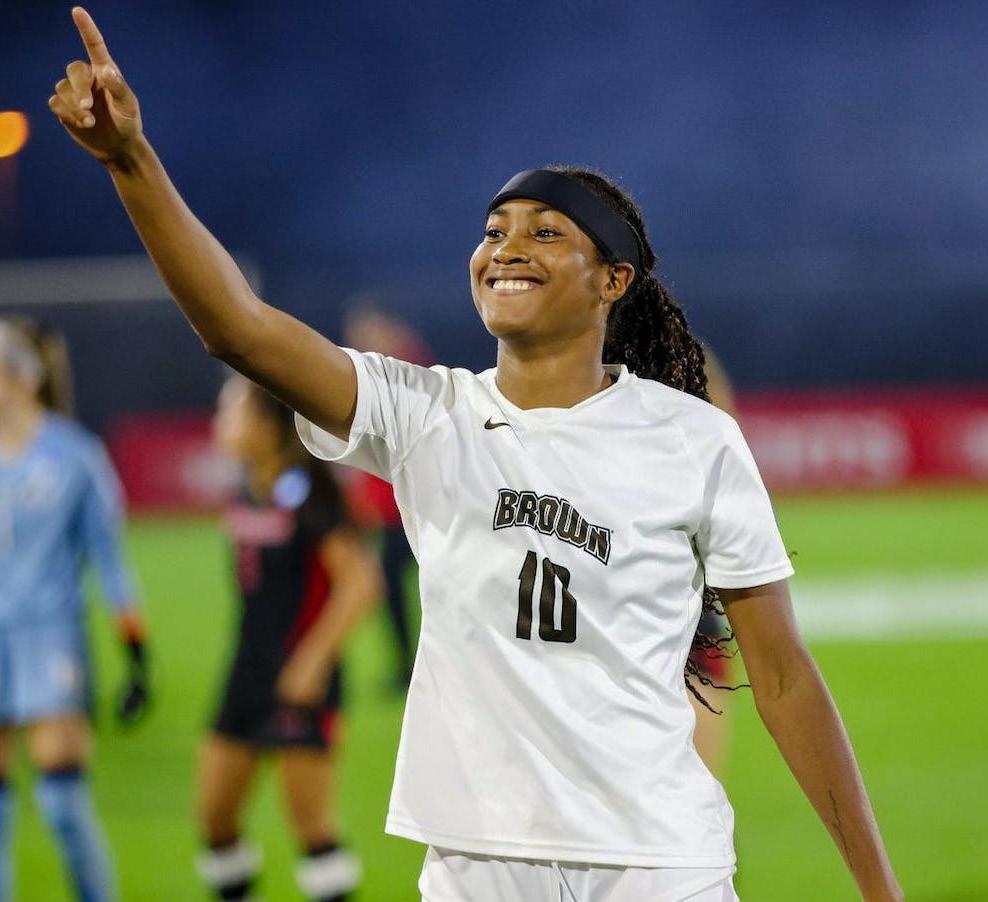
“I don’t think there are thoughts in moments like that. It’s very much instinct. It’s very much trust in your training,” Gagne said. “I think that’s something I’ve been working on since day one, so it’s really exciting to make a save like that.”
Gagne’s save preserved the draw for the Bears, who will on Sunday host undefeated Wake Forest (5-0-1) in another difficult non-conference game.
four and Tierney also scored three. Tymcyna assisted on three goals, with Tierney assisting twice.
“I can just tell you from Sunday morning, this is a different team,” Mercado said. “And we have a lot of work to do. But I think our mindset is to stay together no matter what the score is, as you saw last night” in the comeback victory.
Monday’s matchup with Pacific was a heartbreaking defeat for the Bears. After going up 3-2 early in the first period against the sixth-ranked Pacific Tigers, the Bears found themselves in a hard-fought battle, with neither team managing to extend a lead past two goals for the entirety of the game.
During the opening minutes of the second period, the Bears came back from a 5-4 deficit to bring the lead back to 6-5, but quickly lost it again to Pacific and never regained the lead.
“I mean, we just wanted to play our best and we weren’t worrying about what they’re doing and what (shots) they’re making. I think our focus is on our energy,” said Chang.
“Our focus these past games has been on our energy, our composure.”
In the closing minutes of the match, Chang converted on two penalties to knot the game again from a two-point deficit.
“I think after you shoot one on the same goal, it’s a mind game at that point,” Chang said. “You just need to stay composed.”
The match would remain tied until the Tigers took a two-point lead that the Bears were unable to recover from. After a consolation goal from attacker Trey Rogers ’26, the Bears lost the match 13-12.
“We have a lot of work to do,” said Mercado. “I think our ceiling is high. And we just have to make sure that we get there and surpass it.”
The Bears will continue their season Saturday when they take on Biola University and Long Beach State University in Long Beach, California.
Tuesday, September 5, 2023.
VOLLEYBALL
Volleyball sweeps Mason Invite, continues undefeated surge
2021 Ivy League Player of the Year Cierra Jenkins ’24 records two 40-assist performances
BY LINUS LAWRENCE SPORTS EDITORThe volleyball team (7-0) swept its three matches at the Mason Invite in Fairfax, Virginia this weekend, extending its undefeated season record. In a doubleheader on Friday, the Bears beat the George Mason University Patriots (4-5) in four sets before sweeping the Radford University Highlanders (1-8). Saturday morning, the Bears swept the Robert Morris University Colonials (3-5).
Cierra Jenkins ’24, the 2021 Ivy League Player of the Year, was named Ivy League Player of the Week for her efforts, recording two 40-assist performances against George Mason and Robert Morris. She currently leads the Ivy League with 10.5 assists per set.
Despite winning nine of 10 sets played at the invitational, the Bears participated in a number of close contests: Four sets were decided by three points or fewer, while only two sets were decided by a margin of seven or more points.
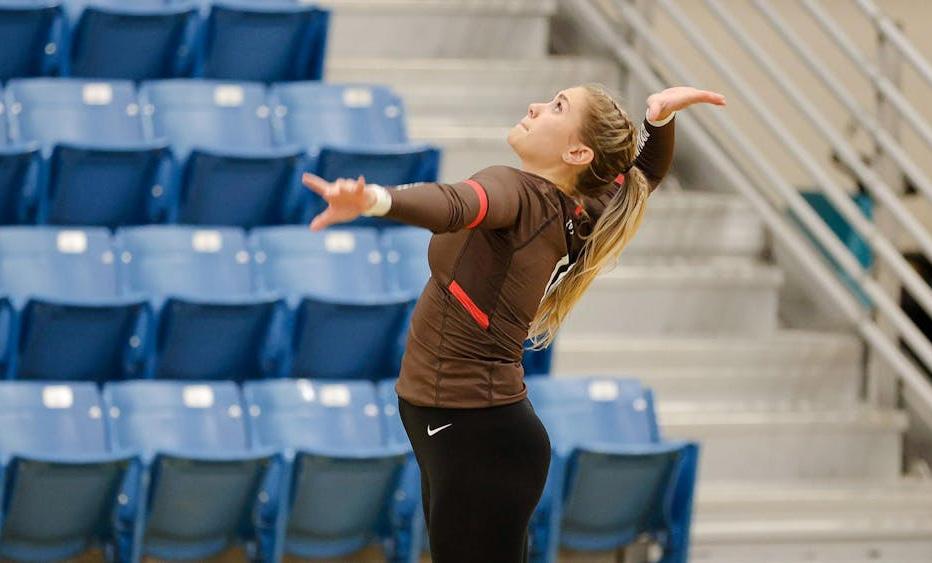
“This group is pretty veteran in their on-court experience and not easily shaken in pressure situations,” wrote Head Coach Taylor Virtue in a message to The Herald via Brown Athletics.“We talk a lot about preparing for big moments and trusting ourselves when we get to them. That’s exactly what we
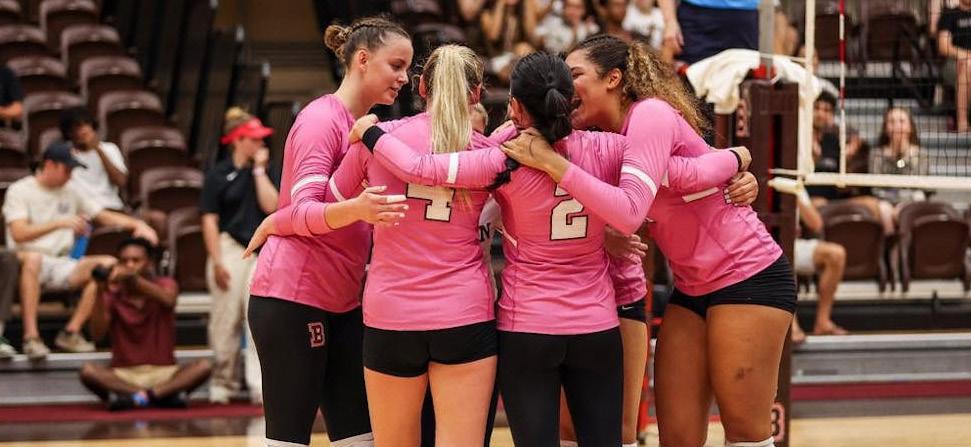
did this weekend and what we will continue to do throughout the rest of the year.”
The Bears’ sole slip up came in the second set against George Mason, when the team blew a 24-21 lead by allowing five straight Patriot points. In the third set, Bruno found themselves up 24-20, and allowed two points before preventing another comeback with a kill from Beau Vanderlaan ’25.
Mariia Sidorova ’26 struck the final kill in the fourth set to give the Bears the win. Sidorova finished the match with 16 kills, tied for a career high, and finished the weekend with 37 kills overall — her most in a three-game span with the Bears.
Another standout performance came from Jessie Golden ’26, who racked up a career-high 28 digs against George Mason.
“In the match against George Mason,
I felt like our defense was able to read and move behind the block well, which led us to more digs,” Golden wrote in a message to The Herald via Brown Athletics. “We were anticipating what the opponent’s hitters were going to do.”
In the match against Radford, the Bears’ defense further locked in, holding the Highlanders to a .046 hitting percentage. This included a negative percentage in the first two sets, when the Bears tallied nine blocks.
“A big part of their low hitting percentage was our block,” Golden wrote. “Our block was big, so it forced the hitters to tip and roll. Once we were able to pick these shots up on defense, it also forced them” to commit errors.
The Bears and Highlanders remained neck-and-neck for much of the third set,
with neither team holding a lead greater than three points. With the score tied 25-25, the Bears scored two straight with a kill from Hannah Flannery ’26 and an attack error to earn the win.
The Bears’ offense displayed a strong showing against Robert Morris, recording a hitting percentage above .300 in all three sets. In the second set, the Bears found themselves down 20-17, but promptly went on a four-point tear with three kills from Kate Sheire ’24. Sheire totaled 38.5 points across the Invite’s three matches.
With the score knotted at 24, Vanderlaan struck back-to-back kills to seal the victory for Bruno. The Bears went on to win the third set 25-18.
The team has now won seven consecutive games and 21 out of 23 sets to open their season under the leadership of Virtue, who is in her first season as head coach after serving as an assistant coach the past two seasons.
“Coach Virtue has been a great leader for our team because it feels like we are a family,” Golden wrote. “We know she can lead us to wins and to play the best we can as a team.”
“She’s really put a lot of love and hard work into this program, and I think it’s gonna show this season,” Kayla Griebl ’25 said of Virtue after a home win against Stonehill last week.
This weekend, the team will play three matches on the road in Connecticut against Binghamton University, Michigan State Uni-
versity and the University of Connecticut before beginning Ivy play in New Haven against Yale Sept. 22.
After winning the Ivy League Championship in 2021 and placing second in 2022, the Bears’ surging start to the season continues to raise expectations for what the team could accomplish. But according to Virtue, the team’s approach will be to remain concentrated on the game ahead of them.
“The next match is the most important one for us,” she wrote. “We’re going to focus on being ready for our Saturday afternoon match and then we will take it one moment at a time after that.”
SCORES RECAP
Volleyball sweeps Stonehill, improves to 4-0 on season
victory
BY LINUS LAWRENCE SPORTS EDITORThe volleyball team (4-0) handily def eated the Stonehill College Skyhawks at the Pizzitola Sports Center Tuesday, Sept. 5, sweeping the match 3-0. The team remains undefeated under the leadership of new Head Coach Taylor Virtue, who was promoted in April after serving as an assistant coach for the past two seasons.
“I’ve got a pretty veteran squad who’s really talented and hungry,” said Virtue. “A lot of this group won an Ivy League Championship in ’21, and so they’re ready for more of that. When you have a group that cares as much and works as hard as this one does, it’s not hard to start off the year like this.”
With the first set tied at 2-2, Brown went on a 9-0 surge, going on to dominate Stonehill 25-15. The Skyhawks never held a lead in set two, with the Bears’ offense hitting .630 to take another commanding 25-11 victory.
“Even with such a loud crowd and the heat that we had today, (we have to focus) on how we play,” said Beau Vanderlaan ’25. “I think mainly in the first two sets we did a really good job of doing that.”
Vanderlaan — a unanimous Ivy League Rookie of the Year in 2021 and unanimous First Team All-Ivy Selection last season — had a career night, hitting a remarkable 8-for-10 with five blocks in the match.
Cierra Jenkins ’24, the 2021 Ivy League Player of the Year, led the team with 24 assists, setting seven of Vanderlaan’s eight kills.
“I really owe it all to the passers and the setters,” Vanderlaan said. “Cierra is unbelievable. I can’t even express how good she is.”
Jessie Golden ’26 led the team with 12 digs, giving her a total of 68 in four games to open the season.
“Jessie leads the back row like no other,” Vanderlaan said.
The third set proved more challenging for Bruno, with the team falling in an early 11-7 hole before a six-point run. The score remained close as the two teams went back and forth. Clinging to a 19-18 lead, the Bears finished strong on a 6-1 run to earn the clean sweep.
“In the third set, we started off a little bit slower, but we found a way to get back and pull ourselves out of that hole that we dug,” said Kayla Griebl ’25. “I think that just shows that we have a lot of fight on our team, and no matter who you put in we’re going to find a way to win.”
Griebl finished the match with 10 kills, marking her first double-digit kill total this year after earning it seven times last season.
“My focus has shifted a little bit,” Griebl explained. “I’m trying to play higher on the offense, and that will result in me not getting blocked as much.”
Mariia Sidorova ’26 followed Vanderlaan with nine kills on the evening, while Jilienne Widener ’24, Hannah Flannery ’26, Gabby Derrick
’25 and Jenkins each racked up four. Derrick and Flannery also recorded three blocks apiece.
The Bears will next compete at an invitational at George Mason University in Fairfax, Virginia later this week, followed by a trio of games against Binghamton University, Michigan State University and the University of Connecticut. The team’s Ivy opener is set for Sept. 22 against Yale in New Haven.
The schedule is “definitely gonna ramp up in competition,” Virtue said. “It’s gonna be a challenge, but that’s exactly what we need heading into Ivy” play.
Looking forward to the match-ups against “physical” teams like Michigan State and UConn, Vanderlaan said the group is “really excited to
see what we look like against (teams) that huge (and) competitive to lead us into Ivy play.”
Coming off two of the most successful seasons in program history — winning the Ivy League Championship in 2021 and making the league finals in 2022 — Vanderlaan confirmed that expectations are “of course high” this season. “We want to win the league,” she said. “I think that’s every team in the Ivy League’s goal.”
“We have the players to do it (and) the leadership to do it,” Griebl said. “And the coach to do it,” Vanderlaan added.
RISD BioPods aim to rewild Providence River, purify waterways
Miniature wetland ecosystem invites community members to regenerate city’s river

 BY JULIA VAZ METRO EDITOR
BY JULIA VAZ METRO EDITOR
Silently floating through the Providence River, a handful of BioPods are naturally working to reestablish a whole ecosystem. The modular, wedding-cake sized pods — built out of mycelium mushrooms and topped with native wetland plants — hide a series of holes, wax channels and root systems that support the growth of wetlands. Through this process, the RISD BioPods team hopes the river can begin to restore its ecosystem.
The Providence River and its entire watershed, “has been polluted over the course of many generations,” said Avantika Velho, one of the BioPod designers. Even though the river has become cleaner in recent years, Velho noted a “blank space” in Providence’s 2022 Envi ronmen
Manini Banerjee, Varun Mehta and Katia Zolotovsky, assistant professor of design at Northeastern University, RISD Research Affiliate and faculty lead of the grant project, was one of the inaugural recipients of the Somerson Sustainability Innovation Fund. The grant, created in 2022 by the Rhode Island School of Design, offers awards for student and faculty projects focused on the intersection between sustainability and design. In less than a year, the now-seniors and recent graduates have been able to prototype a low-cost system to purify waterways and empower communities.
Embarking on such a mission as designers was challenging, Mehta said. But the members’ professional backgrounds enabled them to focus on the community-facing aspects of the project.
“The value of approaching this from a design perspective rather than necessarily an explicitly scientific one … is that we’re able to consider … who has con
ology (or allow them to understand) what’s going into it,” she said.
The focus on community, combined with creative modes of research, is precisely the strength of a sustainability innovation fund dedicated to artists and designers, explained RISD Director of Research Soul Brown. While Soul Brown rec ognizes that many funds provide compensation for climate- and environment-focused projects, the RISD fund specifically centers creative solutions from artists and designers.
“They bring their own unique practices that researchers might not have familiarity with and therefore might not consider.”
For Soul Brown, the RISD BioPods project encapsulates many aspects of the SSIF mission. The project, she said, highlights that “nature can repair itself,” without help from “the artificial.”
The BioPods team partnered with several organizations both within and outside of RISD during the project’s development.
In an email to The Herald, Jennifer Bissonnette, interim director of RISD’s Nature Lab, wrote that the BioPods team worked closely with the lab to address a series of questions, specifically those involving the best plants to ensure restoration, how to sustainably harvest local plants and how
ical function back to areas where it’s critically needed, but also provide the opportunity for passersby to focus a bit on the living world we’re so deeply connected to and consider
attention to developing workshops and even more accessible versions of the BioPods. A “cupcake version” of the BioPod, as described by Mehta, will be designed to boost affordability and accessibility — so “someone could build (it) with no background
BioPods. Banerjee recounted how their table at the event received many visits, ranging from environmental scientists ready to discuss the science behind the BioPods to small children who were attracted by their modular shape.
The experience, Mehta explained, is part of their user research, which is largely focused on how to engage and educate community members. “How can you make them understand why this is important, both to them, to the people around them and to the city they live in? Why is water health important?” he asked.
The next morning, the team gathered by the riverbank to launch the BioPods, joined by passersby. “I talked to some older people
The team is oping workshops that train citizens to build, fabricate and maintain the pods, while explaining why they are needed to clean the river, Velho explained. The team will test the workshops throughout the fall.
Velho hopes that the project can be expanded across New England and even globally, as they explore more funding opportunities. “Within the realm of this grant, it was enough to fund the initial research development and prototyping, but hopefully with all of these other engagements we can fundraise further,” she said.
As part of their fundraising efforts, the team will attend Rhode Island’s 2023 Stormwater Innovation Expo in October. The event “aims to empower industry professionals” by introducing attendees to “innovative

Flooding, leakages strike U. buildings
Year after flooding displaced Keeney Quad residents, Brown buildings flood again following thunderstorm
BY KATHY WANG AND NEIL MEHTA UNIVERSITY NEWS EDITORSSeveral campus buildings faced flooding and leakages following a flash flood warning in some parts of Providence County Sunday afternoon.
Sears House faced the most flooding, with water entering the basement at around 3 p.m. Last fall, Sears also saw flooding when heavy rain hit Providence.
Water also leaked through ceilings onto the first floor of Sternlicht Commons and the third floor of Harkness House. At the time of this story’s release, the Department of Facilities Management did not respond to requests for comment.
Multiple students took to social media to share information and photos of the flooding.
Tyler Gurth ’25 posted a video of the Sears basement floods on Instagram and a photo on the anonymous messaging board Sidechat, where it garnered around 400 upvotes from Brown students within two hours.
And Jessica Ni ’25 posted on Sidechat about her dorm room in Harkness facing a ceiling leak.
This is not the first time University buildings have experienced flooding, especially during extreme weather conditions.
Last September, 35 first-year students were displaced from their dorm rooms due to flooding in the basement of the Archibald-Bronson dorm in the Keeney Quadrangle, The Herald previously reported.
Hall residents were evacuated due to flooding in portions of the building’s east wing, The Herald previously re ported. Rooms in all five residential floors and hallways of the third and fourth floors were affected.
pipe bursts on campus in the past, leaving buildings such as Andrews Hall, Diman House, Sayles Hall, the Sidney Frank Hall for Life Sciences and the Biomedical Center flooded, The Her ald previously reported. For those buildings, restoration efforts lasted through April.
student and “returns,” or unused funds from student groups and “revenue surpluses from large events like Spring Weekend and Gala.”
Leftover money carries to the next academic year as a “forward balance,” according to the statement. The board aims for the forward balance to stand at $300,000 every year in case of any fluctuations in the return funds that might leave the board with no money to spend.
But heading into the 2019-20 academic year, UFB’s forward balance reached over $1 million — a result of unknowingly accumulating balances throughout previous years, since it only then gained access to its total financial records, which dated back to the academic year of 2008-09, the statement said. This left UFB with a $1.04 million surplus.
“When the surplus was found, UFB at that time realized that there was no point in increasing the student activity fee because they wanted to spend all this money,” Chopra said.
Before the surplus, UFB spending “looked really, really different,” according to Chopra. “After the surplus was found, spending got ramped up,” and then the COVID-19 pandemic hit.
With COVID-19 restrictions nearly completely removed in the 2022-23 academic year, UFB started with around $2 million from the student activity fee and a $1.2 million forward balance, leaving them with $3.2 million to spend, Chopra said.
We believed that “we (needed) to do this massive stimulus in order to get people involved in clubs and get clubs to flourish as much as possible” after pandemic restrictions eased, he added. “Now we’re in a situation where the stimulus was very successful, and we are in a belt-tightening era” in terms of money.
The group hadn’t intended to spend the entire surplus, instead leaving a forward balance of $150,000, Chopra explained in a
change course in order to preserve a healthy surplus,” he added.
UFB spent around $3.2 million last year, leaving them with “pretty much zero” forward balance heading into this school year, according to Chopra. Consequently, the total revenue for the 2023-24 academic year came only from the revenue from the student activity fee, which was $2.1 million. The amount requested by student groups in annual funding exceeded $3.6 million, leaving a disparity of over $1.5 million, Chopra said.
According to Chopra, UFB requested a $50 per year increase in the student activity fee to $336 per year per student, which he called a “very conservative number.” But UFB was only granted an annual increase of $14, bringing the total to $300.
Even with that increase, the student activity fee revenue would not have brought UFB’s budget back to the $3.2 million it had last year — or even $3 million. “We asked for $50 because we thought that would be a very reasonable stepping stone to getting us back on track,” Chopra said. “That would not have actually maintained that $3.2 million of spending.”
At the start of last year, UFB had planned to spend “ideally almost everything” in their account with the hope of not having a surplus, according to Chopra.
Back-end support
To host events, groups need various University or municipal services — such as Event Operations, the Department of Public Safety, the fire marshall, Facilities Management or Media Services, Chopra said — but those services aren’t free.
According to Chopra, UFB “gives money to (these departments) on behalf of groups to the back-end” so that groups don’t have to request these services themselves and return to UFB with an invoice.
UFB has around $519,000 left this year after allocating for student groups’ annual requests, Chopra said. But this amount needs to cover the back-end support mentioned above — as well
as club baseline funding, which all groups receive based on their group category, and supplemental funding requests by groups later in the year.
On Monday, UFB announced in an email to student groups that “there will be limitations on what is automatically covered by UFB” for services from Media Services and Event Operations this year, given the organization’s “present budgetary constraints,” according to the email, which was shared with The Herald.
The email included a list of covered equipment and services and stated that anything else “will require the group to cover the cost either with approved UFB funds or raised funds that are currently available in a group’s account.” On the list, “tech rehearsal support,” “video production services” and “Zoom web conferencing” are “not covered by UFB automatically.”
Last year, groups were able to request services before quotes or invoices went to UFB or the Student Activities Organization, leading to “a number of very surprising invoices for tens of thousands of dollars,” Chopra explained in a message to The Herald.
Chopra emphasized that “safety costs” are UFB’s priority. “That’s one area where we are not doing any budget tightening at all.”
The board has also decided to switch back to an annual model of funding for this school year because seeing “all the budgets together” will help members make “more equitable decisions,” Kim said, especially with reduced revenue to disburse. He added that UFB looked at groups of a specific type — cultural, for example — together, and compared their budgets to ensure decisions were consistent.
According to Chopra, UFB also looked at “per person costs with certain kinds of workarounds in terms of ensuring equity” and “the ability for different clubs to throw different events,” and worked to ensure that events that have historically happened will still happen.
For some groups, this switch has brought difficulties: The Brown University Swing Club has to plan events without group input, Irene Chen ’25, the club’s president, said, while Brown
SASA was only granted 28% of the annual budget request they submitted to the Undergraduate Finance Board, according to Roshan Parikh ’24, president of the club. The requested budget was just slightly above last year’s sum received from UFB, accounting for price increases from vendors, Parikh added.
SASA will have to redirect money reserved for hosting fundraisers for charities — such as CanKids, which supports childhood cancer patients in India — to hosting their yearly events due to their funding shortage, said Mimi Sawhney ’25, the club’s treasurer.
Brown Mock Trial, which placed sixth at a national tournament last year, received almost $10,000 less than the amount they requested, Bianco said. He added that the annual request they submitted had already been reduced from the amount that they received the year prior.
According to Bianco, having placed sixth at nationals last year, the mock trial team is getting invites to “pretty prestigious” tournaments that they haven’t gotten in years — but due to budget constraints, they have to turn some down.
“We’re kind of worried that we won’t be able to capitalize off the success of (last) year,” Bianco added.
The Class Coordinating Board — another branch of student government that hosts class-wide activities — received “around 80% of last year’s funding,” according to a CCB statement sent to The Herald. And Swing Club received almost 30% less than last year — which jeopardizes its winter ball, an event essential to the club’s traditions and the larger Providence swing dance community, Chen said.
Lily Seltz ’25, one of The College Hill Independent’s managing editors, said that funding received by The Indy was not enough for printing their full volume in color consistent with previous years.
After polling their staff on how they wanted to proceed, managing editors of The Indy fundraised over the whole summer to print at a normal pace this semester.
“It’s not sustainable for us to be doing this level of fundraising for really any amount of time. It was already a real stretch this summer,” Seltz said, adding that the majority of the donations they received were
pad into the often very gatekept and
ing,” said Angela Qian ’24, another
versity is something that doesn’t just help us now to take a load off our backs,” she added. “It truly does help so many students, past, present and future to really change their lives and shape the
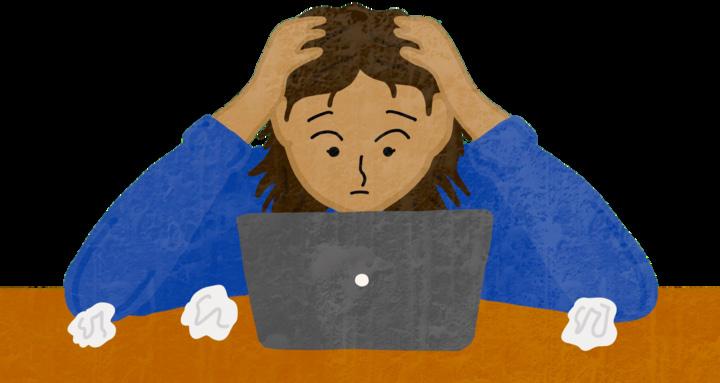
Gupta ’25: It’s time we rethink sexual metaphors to fit
Have you ever used bases to describe a sexual encounter? The baseball bases analogy has been used for decades in literature, media and real life to not-so-subtly indicate the extent of physical intimacy in a hookup. According to the teen magazine, Seventeen, one definition of the bases is as follows: first base is kissing, second base is touching above the waist, third base is stimulating below the waist and fourth base (or a home run) is having sexual intercourse. Despite the metaphor’s long-lived legacy, it is outdated. Not only does it rely upon a traditional, heterosexual and cisgender definition of sex itself and misogynistic ideas about men “scoring” with women and tallying their sexual conquests, the bases also imply linear progression of increasing intimacy. But today, sexual encounters often serve as the predecessor for a romantic encounter. What do the bases mean in practicality when hookup culture has
made a genuine conversation feel more intimate than sex for some young people? We, as active or passive participants in this culture,
Plenty of love stories on campus started with dance floor makeouts in frat house basements or from random Tinder hookups driven
no longer follows the standard baseball metaphor like many of us were taught when we were younger.
If sex is first base for a sizable chunk of people, even if it isn’t for most, being able to hang out with that person in a non-sexual context is a home run. A one night stand is first base, and going grocery shopping together is fourth. These jokes poke fun at how nowadays, relationships blossom from sex rather than from emotional intimacy first, which seems to be a pattern among Brown’s student body.
should challenge why these norms are changing and try to understand what implications such a reversal will have on the future of intimacy.
by algorithms. The thought of going on a real date before having a sexual encounter with that person can feel abnormal. The chronology of becoming intimate with someone else
Hookup culture can create pressure to separate emotional connections from physical intimacy. But when we deliberately unlink the sexual and emotional aspects of romantic encounters, we do a disservice to our intimate relationships. We may be physically hitting home runs, but emotionally, we barely reach first base. To me, this says that we are con -
Rahman ’26: The education crisis facing American boys
Today’s higher education landscape looks drastically different from that of our parents. In a dramatic reversal of the United States’ higher education gender breakdown, 59.5% of college students today are women. While both men and women this century are more likely to attend college than in the past, the pace of enrollment for men has been comparatively slower. If current trends continue, we can soon expect to graduate two women for every man receiving a college degree. At Brown, one might fail to notice this trend because, like its peers, the University extends an implicit boost to male applicants in order to keep an even gender ratio. However, like any demographic disparity, this has consequences. We ought to ask ourselves what social, economic and political forces have caused men to overwhelmingly turn their backs on higher education, and work to address them.
For the past two years, I have served as
sity. My experience tutoring is reflected in national trends: Of the 700,000-student drop in undergraduate enrollment during the COVID-19 pandemic, 78% can be attributed to male students leaving college. What’s going on?
We know that college is one of the most significant investments a young person can make in their lifetime. I fear that if men continue to leave college behind, society will leave them behind in return, and this will have wide-reaching adverse effects. In a 2018 study, economists at Stanford University, Harvard and the U.S. Census Bureau found that income inequality between Black and white Americans is driven by differing rates of downward social mobility of men. Furthermore, economic deprivation has been linked to higher levels of incarceration. Thus, increasing access to education may help break cycles of lack of economic opportunity. Additionally, America’s gendered educational divide only exacer-
valued, we ought to change our approach to encourage more men, especially those who are economically disadvantaged, to seek higher education. One science-backed solution may be to simply have boys, in certain circumstances, start school a year lat-
ones, might be seen as queer or feminine, or believe that a man’s place lies in physical labor. This deeply simplistic worldview holds them back and results in sisters getting ahead educationally while brothers are left behind. Part of this phenomenon stems
a volunteer tutor at the Downtown Boxing Gym, a free youth program in inner-city Detroit. Among my male students, I have seen a general disengagement with education that only grows as they progress through the years. In contrast, my female students are more focused and stay out of trouble, and many go on to attend univer-
bates preexisting polarities in American culture, since women and college graduates are more likely to vote Democratic, combining to result in college becoming seen as not only partisan but also gendered.
As we continue to shift to a more knowledge-based economy, in which traditionally masculine physical labor becomes less
er. Neuroscientists have long known that the brains of boys and girls mature at different rates: Girls are more likely to be school-ready at age 5 when controlling for parental characteristics. Delaying school starts yields improvements in many academic outcomes, especially for boys and low-income students. Furthermore, it is imperative that state and federal lawmakers implement programs to encourage men to become teachers, as research shows that boys especially benefit from male mentorship, particularly boys of color. In fact, a study in Finland showed that boys taught by male instructors were more likely to attend college, and girls taught by male instructors were more likely to study technical fields. At the collegiate level, schools ought to reach out to and create spaces for male students, especially low-income students and students of color. Some smaller colleges have even opted to create football teams to boost lagging male enrollment numbers.
On a broader societal scale, we need to reframe the conversation around masculinity. In some communities, academically inclined men, especially working-class
from a lack of male cultural icons closely associated with the value of higher education — ones that compete with household names like Malala Yousafzai and Brown alum Emma Watson ’14. Such icons could channel an “Obama Effect” — a boost to academic outcomes from seeing a role model who looks like you — motivating young men to pursue education and aim higher. While to some it may seem problematic to focus an entire column on aiding an already privileged group, I counter that suffering anywhere merits our full attention. The future of boys is the future of our brothers and our sons, and that future deserves to be bright.
Tas Rahman ’26 can be reached at tasawwar_rahman@brown.edu. Please send responses to this opinion to letters@browndailyherald.com and other op-eds to opinions@browndailyherald. com.
We ought to ask ourselves what social, economic and political forces have caused men to overwhelmingly turn their backs on higher education, and work to address them.
“
We may be physically hitting home runs, but emotionally, we barely reach first base.
I fear that if men continue to leave college behind, society will leave them behind in return.
The Herald is seeking reporters, developers, designers, illustrators, copy editors, columnists, podcast team members and more.
modern dating and start defining them for ourselves
tributing to a culture that discourages emotional vulnerability, which is the foundation of healthy relationships, potentially jeopardizing the health of our future and more serious connections.
It’s normal to feel like relationships that lack emotional intimacy are the most pervasive on campus, but the reality is that most students aren’t looking exclusively for hookups. From those struggling to stay in their long-distance relationships to couples who meet online before ever stepping foot on campus, I’ve witnessed the diversity of what relationships can look like since I first arrived at Brown. These relationships all went through different sexual and emotional stages, or bases, to get to where they are, and certain bases will fit better for some people than they do others. A purely sexual relationship works for some, but it’s important to actively reflect on whether that approach fulfills you too.
I’ve been thinking about the pressure that first-year students on campus must be expe -
type of relationship. First-years are coming from all different backgrounds in regards to
after a sexual one. And for the vast majority of incoming first-years, sex is unfamiliar. Every person has their own phases of a relationship that make the most sense for them and their own ideas about what their “bases” are. But we should be aware of the external pressures that may be impacting the way we engage in them. When you are participating in something that doesn’t feel right, you should take note, because ultimately, in college, we should prioritize self-discovery and defining the “bases” for ourselves.
riencing this year — pressure to have an active sex life while simultaneously searching for a long-term partner. There is no right answer or moral high ground tied to any one
their high school context and dating experience. Some cannot fathom having sex with someone without going on a date beforehand. Others have only found romantic connections
If you have questions about sex or relationships that could be discussed in a future column, please submit questions to an anonymous form at https://tinyurl.com/BDHsexcolumn. Anusha Gupta ’25 can be reached at anusha_gupta@brown.edu. Please send responses to this opinion to letters@browndailyherald.com and other op-eds to opinions@browndailyherald.com.
Klein: Entering the new year with humility
As the new academic year on campus coincides with Rosh Hashanah, the Jewish new year, I’ve noticed that some of the central figures in the stories associated with the season, specifically the biblical Abraham and Sarah, have valuable lessons to impart about transitioning into the new school year.
Sarah and Abraham’s household is the paradigm of hospitality in Jewish tradition. Not only is their tent open on all sides, welcoming visitors from every direction, but the midrash on Genesis 18 also reveals the remarkable humility of Abraham. As he sits at the entrance of his tent, recovering from circumcising himself at the age of 99, three men appear. He stands and rushes toward the men to greet them, wash their feet and ask his household to prepare a multi-course meal.
Perhaps less obvious is that the visitors are also doing something important — they are visiting someone who is recovering. While the story teaches the importance of being a good host, it also becomes the bedrock of the tradition of showing up for people who are not at their best.
In my first 10 weeks at Brown, I have noticed that we often talk about “taking space and making space.” What a great way to come into any new community: asking ourselves how we can lead with the right amount of self-confidence and modesty to show up authentically but also ensure that we are making room for new people. Jews sometimes refer to this character trait as “anavah,” the Hebrew word for humility. Developing our anavah is the process of striving for that balance of taking and making space.
When we meet new people, there is an opportunity to emulate the loving kindness of the biblical Abraham by graciously going out and making sure everyone feels welcome in our tent. We also have the opportunity to follow the example of the three visitors who showed up for someone when they were vulnerable. Whether you just arrived here from Madagascar, Melbourne, Massachusetts or anywhere in between, I hope you have arrived on campus with confidence but also with some measure of vulnerability.
I want you to feel great about being at
Brown — I sure do. But I also know that it’s often the listening rather than talking, the
when we listen intently and make space for ourselves and each other to grow in joy and
pushing beyond our comfort zone and the admitting our missteps that cause us to grow most profoundly. When we make space for other people, as the Brunonian dictum suggests, we also create valuable space for personal growth. Showing up means asking for help and noticing when someone else may need it. Choosing to seek help and understanding this as a sign of strength is perhaps one of the best lessons we can learn, whether inside or outside of the classroom.
In the story, the three guests will announce that Sarah, who has struggled with infertility, will have a child the following year — quite the miracle given the couple’s age and history. Their words bring laughter to the household. These days, people might not reference miracles in the way we often see in many foundational religious texts. But when we consider the power that we hold
laughter, we might be creating experiences for one another that feel just plain miraculous.
May we always take space and make space. May all of our new beginnings be associated with the broadest of curiosity, the warmest of hospitality and the kindest of care. L’shana tova u’metuka. May this new year be good and sweet.
Rabbi Jason Klein began his work as the associate university chaplain for the Jewish community and rabbi at Brown RISD Hillel this summer. He can be reached at rabbijason@brown.edu. Please send responses to this opinion to letters@browndailyherald.com and other op-eds to opinions@browndailyherald.com.
It’s often the listening rather than talking, the pushing beyond our comfort zone and the admitting our missteps that cause us to grow most profoundly.
“
When we deliberately unlink the sexual and emotional aspects of romantic encounters, we do a disservice to our intimate relationships.
“
when we consider the power that we hold when we listen intently and make space for ourselves and each other to grow in joy and laughter, we might be creating experiences for one another that feel just plain miraculous.
“
‘Red, White & Royal Blue’: Idealistic to its grave
BY RYA VALLABHANENI ARTS & CULTURE EDITORWhile a certain level of uncomfortable cheesiness is expected in romantic comedies, there is such a thing as crossing the line. Audiences can only be subjected to so many overbearing love songs and cliche pick-up lines, even when a film centers around a budding relationship. “Red, White & Royal Blue” spends most of its runtime in this more intolerable realm of romance. In a little under two hours, the film manages to travel so far past the line that it leaves any semblance of reality far in the distance.
REVIEWThe premise of “Red, White & Royal Blue” is immediately absurd. Based on the novel by Casey McQuiston, the film follows a romance between Alex Claremont-Diaz (Taylor Zakhar Perez), the first son of the United States, and Prince Henry (Nicholas Galitzine), second in line to the English throne. At the beginning of the movie, the young political figures hate one another: Alex is about as confidently American as one can get and Henry largely comes across as an insufferable snob. Their dislike, of course, turns out to be the result of a misunderstanding and soon begins to dissipate. In a matter of only a few months, Alex and Henry begin to flirt, see each other in secret and inevitably fall in love.

To their credit, Zakhar Perez and Galitzine have incredible chemistry together. Even at the beginning of the
movie, when the two are still only pretending to like each other to maintain their public images, it’s hard not to note the chemistry jumping off of the screen. The characters become even more likable as each grapples with how to exist outside of the heteronormative expectations imposed upon them. They wish for acceptance — from both each other and their respective countries — and the struggle is at times heartbreaking.
Unfortunately, the low-quality acting makes any humorless scene in the film difficult to watch. Both Perez and Galitzine are fine in quick moments of comedic relief, but it becomes difficult to take them seriously any time the two attempt to be vulnerable with one another. During a central argument in the film, for instance, the actors’ poor performances end up taking away from
what’s actually decent writing. Alex tells Henry that he wants to “figure out a way to love each other on our own terms,” but he does so with such forced sincerity that the line falls flat.
The fact that the film’s settings are at times clearly fake only contributes to its detached sense of reality. A computer-generated Washington Monument and the backdrop to Alex’s first kiss with Henry — an incredibly simulated-looking tree — are among the more painful of these backdrops. There additionally appears to be a gap between the movie’s understanding of American politics and how politics actually function today. Alex’s view of the U.S. government is overly optimistic; he’s the pinnacle of a young, idealistic kid who really just wants to help people. He paints his own queerness as consistent with the ideal of American liberty
and finds that the public immediately accepts him for who he is. Admittedly, it’s hard not to grow frustrated with such a one-sided depiction of queerness in America that ignores the unjust treatment that LGBTQ+ community members actually face.
As a result of its considerable distance from reality, any level of tension in “Red, White & Royal Blue” remains relatively low. Both Alex and Henry’s deepest fears — that their parents, grandparents and countries will object to their relationship — never really come to fruition, which turns the ending into a classic happily-ever-after. Given the cliche trajectory of the film, such perfect last few scenes come as no surprise. To its credit, “Red, White & Royal Blue” is at least consistent, remaining absurdly idealistic up until its very last minute.
Dickensian characters, style constrain ‘The Fraud’
Despite thematic breadth, Zadie Smith’s newest novel lacks emotional depth
BY LILIANA GREYF SENIOR STAFF WRITERZadie Smith’s newest novel is somehow more British than any she’s written before. Beyond its setting in northwest London and frequent Cockney dialect, “The Fraud” — Smith’s first stab at historical fiction — is shaped by generations of distinctly English literature.
The book follows William Harrison Ainsworth, a 19th-century writer who failed to reach the heights of his competitors, all of whom are also featured in the novel. But the story is told from the perspective of Eliza Touchet, Ainworth’s aging cousin and housekeeper. Encircling this subtle fictional biography are, in classic Smith fashion,
several larger themes: colonialism, abolition, womanhood and the purpose of literature.
The fraud in question, too, is a historical tale. Touchet becomes fascinated with the ongoing case of Sir Roger Tichborne, a man who claimed to be a long-lost heir to a wealthy family and developed a cult-like following. Touchet becomes enraptured by the fictionalized version of Andrew Bogle, a man formerly enslaved by the Tichborne family who supported the defendant’s case. After years of criticizing the moralizing and deceitful art form of the novel, Touchet begins writing her own about the captivating case.
There is much to be said for Smith’s work, which can — like her past pursuits — be called a feat. Smith pulls together disparate strands of human experience into a cohesive, intense, comedic and engaging narrative. Her work is confident and daring and has often been
compared to Dickens’. Like Dickens, her characters contain a controversial “hysterical realism” that she has herself corroborated: They are heightened to a hyper-literary realm, transcending naturalness to serve the experience — and often enjoyment — of readers.
“The Fraud” is consistent with this practice — its characters sometimes become caricatures. Even as they defy stereotypical boundaries, they repeat their characteristics as if instructed to perform as themselves. This establishes easily and quickly the world in which the book operates. The expectations, desires and auras of the characters are in action almost immediately.
And yet, this simplicity can constrain. The dialogue is witty but sometimes stilted. At the height of drama, descriptions drag on for the sake of scene-setting. Smith walks a fine line between traditional, elevated prose and a loss of personhood. Though her
characters are historical figures, they don’t feel real.
Smith’s characters rarely transcend the pages. Despite the excitement and profundity of the narrative, its readers are constantly aware of the book’s solid form. Readers are assaulted with Touchet’s theories about the purpose of literature while simultaneously conscious of the larger narrative’s existence.
The novel’s 183 chapters, which stretch across eight volumes, enhance this consciousness. Just as tension folds or love begins, a page with a header appears, stepping in between the reader and the possibility of an encompassing narrative effect. These chapters shift in place and time, making it necessary to calculate and return to the age and positionality of the characters.
Perhaps Smith — who is a purposeful, skillful and beloved author — is aware of these stylistic and functional
contradictions in her work. Perhaps it is even her goal: to emulate and critique classic 19th-century English literature. Whatever her intentions for “The Fraud,” Smith fails to captivate with narrative construction alone. Rather, it is the small moments of Smith’s voice that can be credited for illuminating her past success. On page 36, Smith hides a magical depiction of forbidden love, working masterfully within historical constraints. Volume five, chapter seven pushes stunningly against Touchet’s predisposed notions about Sarah, Ainsworth’s second wife. And of course, there is Smith’s distinguished humor — a whimsical banter woven excellently through the book’s pages.
“The Fraud” does not showcase Smith’s true talents. But luckily for readers, Smith is also comparable to Dickens in volume: she has plenty of previously published work that does.
Olivia Rodrigo’s ‘GUTS’ brings female rage to a new generation
Rodrigo wrestles with societal expectations, heartache in newest album
BY DAPHNE DLUZNIEWSKI SENIOR STAFF WRITEROlivia Rodrigo launched to star status with her 2021 debut album “SOUR,” in which she blended the nostalgia of 2000s pop-punk with touching lyrics about teenage heartbreak. Her sophomore follow-up “GUTS,” released Sept. 8, follows in the footsteps of “SOUR” with its rock-style instrumentals and vulnerable songwriting. The album is built on her frustration with bad relationships and, more complexly, the societal pressures she faces to look and act a certain way. Rodrigo’s musical interpretation of these two subjects positions her as a powerful voice of her generation.
“GUTS” kicks off with “all-american bitch.” The dynamic song juxtaposes verses about the difficult expectations of femininity with a punchy chorus exposing the absurd image of the perfect “all-American” girl. She knows how to pull out and play with the fun and ironic aspects of the ever-crushing burden of womanhood, as also exemplified in “ballad of a homeschooled girl.” In the high-energy song, she lists entertaining examples of times she’s slipped up while trying to toe the line of socially acceptable behavior. For example, she sings that she embarrassingly “Thought your mom was your wife / Called you the wrong name twice.”
REVIEW
Her confrontation with these feelings of discomfort in her own skin is also conveyed in more tender forms. In “lacy,” a delicate ode to the personification of the perfect woman, Rodrigo beautifully captures the overwhelming desire to compare herself to others whom she views as flawless.

She builds on this theme in “pret ty isn’t pretty,” in which she admits all the ways that she has tried to meet these unattainable beauty standards. In the first verse, she sings, “Bought a bunch of makeup, tryna cover up my face / I started to skip lunch, stopped eatin’ cake on birthdays,” before expressing her frustration later in the song that, no matter what changes she makes, they will never be enough. The hon esty of the lyrics is elevated by the overall musicality, which — while co hesive with her other songs — feels fresh in comparison to the soulful ballads or pop-rock anthems that make up the rest of her discography.
“making the bed” describes the dissatisfaction that comes with achieving the status and image she has chased, leaving her “so tired of being the girl that I am.” Yet, her nod to the idiom “you’ve made your bed, now lie in it” creatively sug gests that she feels responsible for trapping herself in this mis erable persona she built. The song is the high point of the album, with a catchy chorus and ca thartic instrumentals.
Heartbreak makes up the second backbone of the album as Rodri
them. The songs begin with sprechgesang — or talk-singing go, a style she embraced throughout “SOUR”
as well. Though this adherence to pop punk-esque vocals fits with the genre Rodrigo is pursuing, it distracts from her true vocal talent. For instance, her voice beautifully moves listeners through her heartbreak in “the grudge,” a song about the emotional wounds inflicted on her by a previous relationship.
Yet, “the grudge,” “logical” and even her number one single “vampire,” released June 30, feel somewhat repetitive, as they are all breakup songs that begin slow and then gradually ramp up. Many of her stylistic choices make “GUTS” feel like an extension of “SOUR,” rather than a standalone record demonstrating her growth as an artist. Rodrigo’s maturity and skill shine in the songs where she is grappling with her self-confidence and image, but her reversion back to the themes of heartbreak without any new developments holds the album back.
Still, these criticisms can be pushed to the side as listeners reach Rodrigo’s closing song, “teenage dream.” In the song, she asks herself “When am I gonna stop being wise beyond my years and just start being wise?” and “When am I gonna stop being great for my age and just start being good?” Like many artists who rise to success at an early age, she struggles with the implications of her fame and the questions of where she should go from here. The piano ballad proves to listeners that, while her youth may function as a thorn in her side, it is also a testament to, and an essential element of, her talent as a songwriter.
‘Talk to Me’ fails to capitalize on terrifying promises
Film from debut directors starts strong, results in very little narrative payoff
BY FINN KIRKPATRICK ARTS & CULTURE EDITORHorror films are in something of a renaissance these days. A combination of small budgets and high demand means that the genre is becoming one of the few places in the current cinematic landscape where new, interesting voices are consistently gaining traction. “Talk to Me,” the debut film of directors and twin brothers Danny and Michael Philippou — known previously for their YouTube channel RackaRacka — is the newest of these films to make some noise. While its commercial success — nearly $70 million in global box office gross on a $4.5 million budget — is an exciting sign that audiences still crave new independent films, the product sadly does not carry the same excitement. “Talk to Me” has most of the parts necessary to be an effective horror film, but the elements it lacks prove large enough to overcome the good things.
The film primarily follows Mia (Sophie Wilde) and Jade (Alexandra Jensen), two high school best
friends who become intrigued by a trend among teenagers in their area involving an embalmed hand and supposed spiritual possession. Mia and Jade, along with Jade’s younger brother Riley (Joe Bird), sneak out one night to go to a party hosted by Hayley (Zoe Terakes) and Joss (Chris Alosio), the owners of the hand. Mia gets a taste of the hand’s power; through a series of verbal commands — including the phrase “Talk to me” — an apparition appears in front of her and then possesses her until she lets go.
Mia is enthralled by this experience and has Hayley and Joss come over to Jade and Riley’s house the next day for more possession fun. In the midst of the festivities, Riley becomes permanently possessed by a spirit and winds up almost killing himself by bashing his own face, leaving him in critical condition.
The kids hide what happens that night from the authorities, instead working to find a way to reverse the possession on their own.
These initial scenes introducing the spiritual forces at play in the film are wonderful. Shrouded in equal parts intrigue and existential terror, there is real hope at the beginning that “Talk to Me” could become a new modern horror clas -
sic. The camera work and effects employed during the scenes be tween the characters and the hand are unique and visually interesting. An uncanny sense of near-realism in these moments of supernatural horror connects the viewer with the characters on screen, even if the terrors they are experiencing are outlandish.

But after all these cool compo nents are introduced, the narrative has to take place — and it’s one that has very little going for it. After the accident, Mia obsesses over uncover ing the secrets behind the hand and learning how to reverse its curse. The resulting film is a mystery that quickly loses all of its suspense and winds up a meandering, con voluted plot of loose ends and poorly developed characters. For the majority of the film’s run time, it is seldom scary and, in the few minutes it is, the scares are consistently of the same nature. The audience is quickly clued in on when scares will happen and how they will go down, and the film never breaks from this formula.
“Talk to Me” winds up being an other horror film that falls into the trap of having a compelling fram
A look at what Brown researchers were up to this summer
Studies published this summer cover AI, parasites, fluid dynamics
BY HALEY SANDLOW SCIENCE & RESEARCHFrom the depths of the ocean to the surface of Mars, this summer proved a productive one for Brown researchers. Professors, postdoctoral students and undergraduate students made notable strides in the fields of artificial intelligence, geology, physics and more, with years of creativity and diligent work culminating in published research for many.
Here’s a look at some of the studies that were published this summer.
Mars
There was once liquid water on Mars. That is no secret, especially not for geologists, said James Head, professor emeritus of geological sciences and earth, environmental, and planetary sciences. What is novel, however, is the discovery of how recently there was water on Mars. Liquid water was present on the planet less than a million years ago — a blip for geologists.
In a study published in Science in June, Head and other researchers, including Ashley Palumbo PhD’20, found through climate modeling that the tilt of Mars caused the presence of liquid water on the surface. Liquid water is likely responsible for creating gullies, networks of channels running down the sides of craters on Mars.
The gullies still move today, as shown by time-lapse photographs of the surface, Head told The Herald. But that happens due to carbon dioxide, which changes the path of the gully as it evaporates. Head’s study proposes liquid water to be the main cause of these gullies, which often take the form of elaborate fans or channels that carbon dioxide evaporation cannot completely explain on its own.
Understanding the timeline of liquid water’s presence on Mars is essential for modeling its climate over billions of years and modeling it backward in time, a process called inverse modeling, Head explained. Geologists are still trying to understand whether Mars started out wet and rainy, and how it got to the dry, freezing state it is today, he added. The new study can help refine climate models for Mars, contributing to more accurate climate models for Earth.
“We have 4.5 billion years exposed on Mars,” Head said. “So that really gives us an opportunity to understand the basic themes of planetary evolution, and then AI can help us predict what’s going on in the future of the Earth as well.”
Sea ice
Head is not the only researcher at the University who has been studying
LAWSUIT FROM PAGE 1
Clark wrote that the University complied with its protocols for addressing sexual misconduct claims in a “prompt, impartial and unbiased” way.
The lawsuit alleges Brown took 159 days to issue an investigative report after Doe registered a formal complaint with the Title IX office. It also alleges Brown didn’t release the official findings and recommendations of its investigation until 175 days after Doe’s
the movement of ice and water: So has Daniel Watkins, a postdoctoral research associate at the School of Engineering, although in a much faster and local setting than Mars.
In a study published in Geophysical Research Letters in July, Watkins, Assistant Professor of Engineering Monica Martinez Wilhelmus and researchers from NASA and Oregon State University showed that the deformation and motion of sea ice as it drifts are influenced by the changes in depth and topography of the sea floor.
“Even though it may look peaceful in photographs, sea ice is constantly moving,” Watkins wrote in an email to The Herald. “It pulls apart, forming openings called leads, and then crushes back together.”
During a trip to the Arctic in 2019, Watkins helped deploy a set of over 100 buoys placed directly on top of sea ice to measure their drift patterns via satellite, assisted by imaging from other satellites and shape detection technology. The research team measured both the ice’s drifting speed and its deformation, tracking its interactions with tidal activity, wind patterns and the topography of the ocean floor.
When ocean depth changes, the study found, so do sea ice dynamics. That’s because the mountains and valleys of the seafloor affect tidal currents, which are stronger in shallow waters — as do “sharp undersea features” like the cliff at the edge of a continental shelf.
The study is important for climate models, according to Watkins. While the effects of wind patterns on ice have been well studied — and are therefore better represented in climate models — the effects of ocean dynamics on ice have received less attention. The study may allow for more accurate climate models that better represent ocean currents and ice dynamics.
“As sea ice gets thinner, we expect that it will be more dynamic, and therefore more likely to follow ocean currents,” Watkins wrote. “Our study provides a challenging test case for simulations of the interaction between atmosphere, ice and ocean.”
Artificial intelligence
While the current whirlwind of artificial intelligence technologies is improving rapidly, AI still makes mistakes.
Deep neural networks — artificial intelligence systems inspired by the human brain — are trained to recognize concepts and make decisions. But once a tool is trained, researchers don’t always know how the system makes decisions or the origin of its mistakes, said Thomas Serre, professor of computer science and cognitive, linguistic and psychological sciences.
Concept Recursive Activation FacTorization for Explainability, a project
initial complaint.
Court records show that the lacrosse player had previously filed a lawsuit, Stiles v. Brown, against Brown in December 2021 alleging that his suspension from the University — which happened before the end of the investigation — was a breach of contract.
On Jan. 25, 2022, a court order allowed him to return to campus, and he graduated from Brown that spring, Doe’s lawsuit said. John Stiles, the name used by the lacrosse
by researchers at the Robert J. and Nancy D. Carney Institute for Brain Science and researchers in France, helps explain how visual AI systems go about solving problems, and thus how they make mistakes. CRAFT was presented in June at the Institute of Electrical and Electronics Engineers/Computer Vision Foundation Computer Vision and Pattern Recognition Conference in Vancouver.
By revealing what artificial intelligence looks at to make a determination, CRAFT can help explain mistakes. For example, CRAFT revealed that images of the large tench fish were often not identified by the fins on the fish or the head of the fish. Instead, “tench” was identified by a different head — most often of an older white man, holding the fish.
The system, trained on that detail of images, might then begin to mistake images of older white men as “tench.”
“That’s what in computer vision or AI we call shortcuts,” Serre said. “Because of what we call biases in the data set — the fact that in many, if not most, images, the fish appears next to a fisherman — the neural network ends up using the presence of the fisherman as a predictor of the class label ‘tench’.”
CRAFT has given insight into how differently humans and AI identify pictures. While humans might use the body or snout to identify a snake, AI might use the grass or sticks around the snake.

Computer scientists can then “harmonize” AI to act like human identification, allowing greater accuracy in tools and insight into human visual processes, Serre said.
“We just don’t want a deep neural network that just solves a task,” he explained. “We want it to solve it in a way that’s consistent with humans.”
Parasites
Over the past ten years, in what began as a project for graduate students in 2013, researchers at Brown have been observing how parasites change the
player in that case, was a pseudonym.
Clark noted that the University complied with the court order that struck down the former lacrosse player’s initial suspension and two-year ban from campus that the University issued in response to Doe’s Title IX complaint. According to Clark, the court decision was granted despite “Brown’s strong objection.”
The lawsuit alleges the former lacrosse player exchanged graphic, explicit photos and videos of Doe with his teammates who
phenotype expression in their hosts by studying parasitic control in amphipods, a small form of crustacean.
Recent sequencing techniques have allowed the researchers to confirm changes in gene expression, proving what has previously been observed about infected amphipods. Their research was compiled and published in Molecular Ecology in August.
When an amphipod is infected with a trematode — a parasitic worm — the crustacean turns bright orange and becomes sluggish, risking exposure to predators when it usually runs from light, study author, Chair of Ecology, Evolution and Organismal Biology and Professor of Natural History David Rand, told The Herald.
Shawn Williams PhD’21, Stephen Rong PhD’21, John Burley GS, Kim Neil PhD’20, Adam Spierer PhD’20, Wilson McKerrow PhD’18, postdoctoral researcher Yevgeniy Raynes, Amanda Lyons ’20, David Morgan MS’22, Bianca Brown MS’21 PhD’21, Nicholas Skvir PhD’22, Naima Emory Okami ’20 — along with researchers from William & Mary University, the University of Southern Mississippi, the U.S. Forest Service and the Marine Biological Laboratory are all listed as authors as well.
“This is blind evolution,” Rand said. “If there’s more color and less mobility, birds can pick them off and eat them. And then it will get into the gut of the bird and then the worm can continue its reproductive cycle.”
The parasite also suppresses the immune response of the amphipod, delaying the rejection of the worm from the body.
The modified gene expression caused by parasites is not unique to amphipods or birds. In mosquitos with the parasite that causes malaria in humans, there is some evidence that infected mosquitos are more likely to bite a human, Rand said.
Understanding the mechanisms of manipulation might allow better inter-
also lived in the senior lacrosse house, where Doe alleges the rape took place.
The lawsuit additionally alleges that some of the defendant’s teammates responded with jokes about the former lacrosse player’s actions.“Only one member of the lacrosse group chat asked if Jane was okay and safe,” the filing alleged.
The current lawsuit also claimed that Doe’s case reflects Brown’s “history and culture of failing to hold male students, and especially male student athletes, account-
ventions to reduce the transmission of malaria, he added, and contribute to the scientific community’s understanding of how biological systems operate.
Fluid dynamics
In science and engineering, spheres often serve as approximations for more complicated objects. With an eventual eye toward understanding how objects like microplastics, insects or machines might move at the interface between flowing water and the surface, a group of Brown researchers started with spheres.
While drag force — the resistance force of a fluid — is already well understood for spheres fully underwater, the interaction between an object at an air-water surface is less understood by physicists, according to Robert Hunt, a postdoctoral research associate at the School of Engineering.
Hunt co-authored a study alongside Assistant Professor of Engineering Daniel Harris, Professor of Engineering Yuri Bazilevs, Eli Silver ’21 and researchers from the University of Illinois Urbana-Champaign, published in Physical Review Fluids in August. It found that spheres partially submerged underwater experience more drag force than fully submerged spheres.
“The water ‘piles up’ along the upstream face of the sphere, effectively applying more pressure … and pushing the sphere downstream,” Hunt wrote in an email to The Herald. Drag is greatest right before the sphere is fully submerged underwater, quickly decreasing once piled up water can flow over the top of the sphere.
“When you think of things associated with water, a lot of them interact with the surface,” he wrote. “You may have heard about a ‘spherical cow,’ a meme pointing out the absurdity of approximations made in science and engineering. As absurd as it can sound, a sphere is often a great approximation for a much more complicated object.”
able for their acts of sexual misconduct against female students.”
“Brown has taken a wide range of actions to encourage a culture in which community members intervene to prevent incidents,” Clark wrote.
“We remain committed to achieving a safe environment for all members of the campus community, and we will further detail the facts and our legal arguments in our response to the court.”
ON-CAMPUS ACTIVISM
Second Activist Coalition Conference brings together student organizers
people in the coalition who are members of multiple” organizations, Garo added.
BY KATIE JAIN UNIVERSITY NEWS EDITORThe Brown Activist Coalition hosted its second Activist Coalition Conference on Saturday, creating a space for progressive campus organizations to share their missions with interested students and discuss inter-club collaborations.
Among the groups involved in the event were Students for Educational Equity, Sunrise Brown, the Teaching Assistant Labor Organization and Students for Justice in Palestine.
‘Easier to navigate’: A new recruitment format
Each organization at the conference had a booth for students to visit, a format that SEE Co-President Meg Henning ’25 said was “more flowy and relaxed” than BAC’s last conference. That conference, held in January, was structured more as a speaker series, where “each group came and spoke to students about what their organization was about,” she added.
“This seemed like a better and more interactive way for people to get to know each other one-on-one, rather than a more lecture-based feel,” Henning said.
The change was not lost on attendees. “I like that it lacked a little bit of structure,” said Eugenia Bamfo ’27, who attended the conference to explore possible organizations to join. “You’re free to explore different things.”
“We help the coalition organize all the different activist groups on campus to get together and do events like this in hopes of bringing students who are interested in activism to this space,” Henning said. “There are so many groups that they can
GRADUATE STUDENTS
choose from, but when we’re all together, they can pick one that might align with their goals.”
Organizers and attendees alike commented on preferring the more intimate BAC Conference to the wider Activities Fair.
“At the Activities Fair, you might feel overwhelmed, but here, it’s easier to navigate. You can just focus on the activist groups (and) find whatever you’re looking for,” said Chloe Chen ’24, a representative for End Sexual Violence @ Brown.
“At the club fair, everything’s hitting you all at once, but here you know that (these are) activist groups, and you know what you’re looking at and looking for. It’s way more put together,” said Shamariah Smith ’27, who attended the conference.
Events like the conference also give groups a chance to broadcast their mission when they might not otherwise be able to. Due to its limited membership, the Student Labor Alliance has not been allowed to set up a table at the club fair for the past two years, according to Peter Haynes ’26, a representative for the organization.
Unity among activist groups
Gabriela Venegas-Ramirez ’26, a representative from SLA, felt that the confer-
ence not only helped attract newcomers but also “facilitated a lot of connections between groups.”
“We talk online a lot,” she said, “but it’s especially helpful to be able to really see each other and connect in person.”
Lily Chahine ’24, a representative from the mutual aid and anti-prison organization Railroad, said that “it’s hard at Brown when everyone’s pigeonholed into different organizations, but (the) issues (they focus on) all impact each other.”
“We’re trying to do more collaborations and expose the ways that prison and carceral structures intersect with other issues like education and homelessness,” she added.
“Our goals are not necessarily separate,” said Isabella Garo ’24, co-founder and community co-lead of Sunrise Brown. She explained how SLA can provide insight into issues of labor in the green transition while SEE addresses the educational inequities and marginalization of low-income people and people of color. All of these issues can tie into environmental injustice.
“As a coalition, our organizations are greater than the sum of their parts when we work together, share our resources and even share our members, since there are several
“When we organize a protest, getting all coalition members to go, not just one group, makes us a lot bigger in numbers and power,” Henning said. “The power in people has been really awesome, and we’re hoping to continue that this semester.”
Attendees picked up on the growing sense of unity between the groups.
“I love to see cooperation instead of division between activist groups,” said Matteo Papadopoulos ’26. “It’s a lot easier to go up against a large institution when all of the activism groups have a similar goal.”
BAC also acts as a vessel through which organizations can share information with one another. “One of the worst parts of student organizing is when the turnover happens and you have to relearn all these lessons that people have learned previously,” Chahine said. “Increasing communication across different groups and seeing where we can support each other makes a lot of sense.”
TALO is working with the Graduate Labor Organization to institutionalize communication between groups by creating the Student Activist Organizing School, a six-week course led by professional union staffers, according to Ronnie Shashoua ’25, an organizer for TALO.
The school “is obviously very relevant for people interested in labor organizing, but it’s also for anyone interested in organizing more generally,” Shashoua said. “It’s going to be a how-to on how to build power, how to reach out to the people that you’re working with and how to really build a campaign that works best for the people you’re trying to help.”
Additionally, groups like Resource Generation @ Brown provide organizers with an educational basis to underpin more direct organizing by enabling them
to talk about their class background, according to Alec Lacerte ’25, a representative from RG.
“I try to make it clear that RG is not a one-and-done,” he added. “Interrogating and talking about wealth is just one tiny aspect of activism, and if people are joining RG they should also be getting involved with other organizing groups.”
According to Simo Klein ’24.5, another organizer for RG, addressing wealth inequality from the outset is a form of “preventative care” to avoid “harm that can happen in activist spaces and cause so much more fragmentation.”
Uniquely Brown
Though coalition-building is an essential aspect of any activism, attendees of the event highlighted that BAC represented both their perceptions of and hopes for Brown as a university.
“When I was looking at Brown, I knew that it was very liberal and that students here care about a lot of issues,” Bamfo said. “I never got to get into protests and organizing in high school, so I’m really hoping that college can be that place where I can become an organizer.”
“This isn’t something that you can find everywhere. Not every city or school has a real activist community, even around problems that they do struggle with,” Smith said. “It’s great to see that the people here care about problems that people elsewhere struggle with.”
“It’s very powerful that the coalition can not only be a space where we’re supporting each others’ work, but where we’re also actively caring for each others’ wellbeing,” Klein said.
Papadopoulos added that BAC’s dedication to “bolstering student voices and student activism on campus” is part of “what makes Brown, Brown.”
U., Graduate Labor Organization continue contract negotiations
Parties tentatively agree on four articles, still discussing pay raise, worker protections
BY KATIE JAIN UNIVERSITY NEWS EDITORThe Graduate Labor Organization continued renegotiating its contract with the University through the summer, tentatively agreeing on four articles in a new contract. The two parties began bargaining in February and have met regularly since — and have still not agreed on higher wages or a new policy surrounding harassment and discrimination. The next bargaining session is scheduled for Sept. 20.
According to Maria Arievitch GS, one of the union’s bargaining co-chairs, GLO and the University recently agreed on an article regarding leave and time off. “We’re really excited to have expanded a lot of grad worker rights in terms of different types of leave that they can take throughout their time at Brown,” Arievitch said.
But Areivitch emphasized that a tentative agreement doesn’t mean any clause is finalized. “You can tentatively agree on each individual article, but that leads up to a full bargaining unit vote on the entirety of the contract,” she said.
GLO and the University also reached a tentative agreement on a “No Strike-No Lockout” article, which prevents the union from striking and the University from lock-
ing out workers at any point.
Additionally, parties have negotiated a “big article on appointments and assignments,” which clarifies teaching assistants’ and researchers’ roles. Both sides also tentatively agreed on an article detailing “union rights and responsibilities,” which include solidifying “the union’s right to spread information on campus, (permitting) access to workplaces to be able to talk to workers and codif(ying) language around the ability to access buildings and table at orientation,” Arievitch said.
“While we have continued to meet with GLO representatives … and have reached tentative agreements on a number of specific provisions (for example, on leaves of absence and time off), the larger economic issues remain points to resolve,” University Spokesperson Brian Clark wrote in an email to The Herald.
Though negotiations briefly paused as students returned to campus, Arievitch expressed that GLO is “really starting to hammer down and focus on our top priorities for this contract.”
“We want real stability for graduate workers throughout their time at Brown,” GLO Communications Coordinator Kate Clark GS said. “We want a raise that allows grads to actually pay for things like rent and electricity, which have gone up a lot in the last two years.”
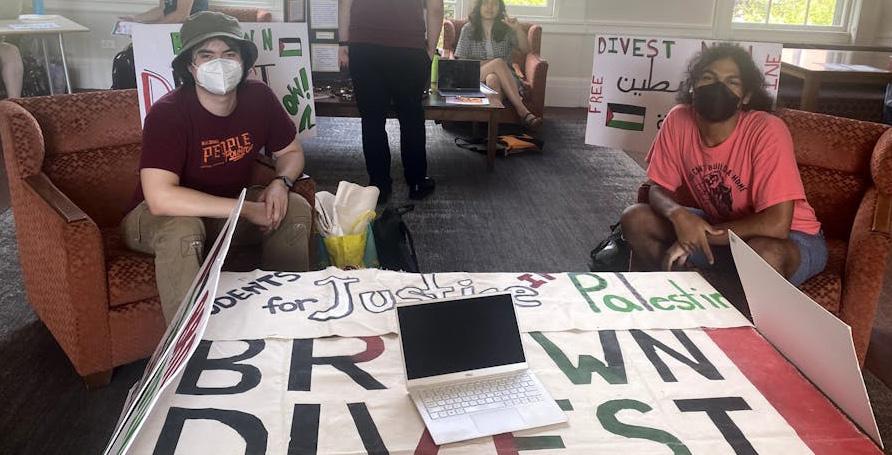
In June, the University proposed a 6.25% raise for bargaining unit members; GLO countered with a 17.8% raise, down
from their initial ask of 25%, according to a bargaining update released by the union.
According to Arievitch, GLO plans to focus on “stipends and health care, the harassment and discrimination process” as well as “workplace safety and COVID protections and protections for our non-citizen and international students” in coming negotiations.
Kate Clark additionally discussed the “equal pay issue” as another priority, referring to disparities in compensation based on how a graduate worker is classified.
“When we say we want equal pay, we mean that we should be paid the same amount no matter if we are teaching or a research assistant or on fellowship,” she said. “Last spring, Brown decided to impose unequal pay on grads, depending on if you’re on fellowship.”
Students on fellowships receive full tuition, health insurance, a health services fee and a stipend to “devote themselves to research, scholarship or the completion of their dissertations” and are “not allowed to hold other work appointments,” according to the Graduate School’s website.
According to Kate Clark, this means fellows are not covered by the bargaining agreement being negotiated and the University separately decides their raises. “That is something we entirely disagree with wholeheartedly, and we are working really hard to get all grads to be paid the same amount,” she said. “The work that we do as researchers brings value to Brown, and
we should be compensated accordingly.”
“The collective bargaining agreement in place between Brown and GLO applies only to graduate students when they are in bargaining unit positions as RAs, TAs or proctors,” Brian Clark wrote. “By law, students on fellowship appointments (and therefore not in RA, TA or proctor positions) are not employees and are not in the bargaining unit — this was a legal point affirmed recently by the National Labor Relations Board Region 1 involving MIT.”
In March, the NLRB ruled that MIT’s graduate students funded by fellowships are not employees, in part on the basis that “the compensation received by the fellows is not directly tied to completing particular tasks, as directed; rather, it is tied to maintaining academic good standing.”
“Last spring, the University established the base stipend for students on doctoral fellowships in 2023-24 as $43,791, a rate that is among the top of all institutions across the country. This is in addition to extensive benefits supporting quality of life,” he added.
Contract expiration and interim wages
GLO’s previous collective bargaining agreement, which was adopted in 2020, expired June 30, but Kate Clark noted that it “doesn’t mean that we aren’t covered by our (old) contract.”
“We did not agree to extend — or haven’t agreed to extend — our last contract,” she said. Still, all of its articles, with the
exception of the “No Strike-No Lockout” and grievance procedure clauses, apply. Those articles will remain enforced until a new contract is negotiated, she explained.
“We have made sure to make our body know that their day-to-day life is not going to be changed by whether the contract has expired or not,” Arievitch said. “We are negotiating a new and better contract for them, and as soon as that’s in effect, anything that needs to be retroactively applied, like the raise, will be.”
Separately from the current or future contract, the University and GLO came to an interim agreement this summer providing for the continued payment of base stipends.
“Graduate students performing instructional and research services will continue to be paid in July and August, as long as they continue serving in accordance with their appointments,” former Interim Provost Larry Larson, Dean of the Graduate School Thomas Lewis and Executive Vice President for Planning and Policy Russell Carey ’91 MA’06 wrote in a letter sent to students June 28. “Graduate students working as RAs, TAs and proctors will receive the same 3.25% increase in stipends that were approved for 2023-24 for graduate students holding fellowships.”
Since the publication of the letter, “Brown and GLO extended the interim agreement on base stipends through the fall semester, with a Jan. 15, 2024 expiration,” Brian Clark wrote.
Simmons discusses book, career during first campus visit in seven years
Former Brown president discusses memoir ‘Up Home: One Girl’s Journey’
BY SAMANTHA CHAMBERS SENIOR STAFF WRITERIn her first official visit to campus in seven years, former University President Ruth J. Simmons spoke to hundreds of campus community members about her new memoir, “Up Home: One Girl’s Journey,” and attended the ceremonial unveiling of the Ruth J. Simmons Center for the Study of Slavery and Justice, renamed in her honor.
“Up Home” is an autobiographical account that follows Simmons’s personal and professional life and experiences facing adversity. Starting in her birthplace of East Texas during a period of widespread segregation, the memoir reflects on the “improbability” of Simmons’s journey and the factors that made her success possible.
“I have come to understand how rich and varied any life can be irrespective of the circumstances thought to dictate a certain path,” Simmons wrote in the book.
During Thursday evening’s book talk, Simmons — joined by University President Christina Paxson P’19 P’MD’20 — shared details about her life with audience members, such as the mentors she encountered in college.
“I was lucky to come to understand that mentors weren’t always the people that you might expect,” Simmons said. She recounted how one of her mentors told her that her work was “the worst he’d ever seen” but ended up being an exceptionally positive force in her education.
During the event, Simmons also recounted some of the obstacles she faced in her upbringing, including growing up without books, being a first-generation college student and confronting impostor syndrome. These experiences, in part, led her to write “Up Home.”
“We need to understand that people living on that basis are not bereft of intel-
ligence or potential — they are bereft of resources,” Simmons said in an interview with The Herald. “If we have the ability to get resources to them, their story can be very similar to my story. I wrote (“Up Home”) to bring into clarity what it means to advance from the margin.”
The book also touches on Simmons’s presidency at Brown. She was the first Black president of an Ivy League university, serving between 2001 and 2012.
Simmons’s presidency was a “time of energy” during which the University “worked to maintain its ethos,” said An thony Bogues, professor and director of the Simmons Center and a faculty member during Simmons’s tenure.
tives was the 2003 creation of the Steering Committee on Slavery and Justice, which researched the University’s historical re lationship with slavery. Three years later, the Committee published its Slavery and Justice Report, which sparked the creation of the Simmons Center, then known as the Center for the Study of Slavery and Justice.
after Simmons was “more than unani mous,” Bogues said.
the Center after her because she was a pioneer and an educator throughout the entire process,” he added.
Renaming the Center after Simmons is “poignant” given her devotion to helping students of color, said Taiese Bingham-Hickman, executive director of The Leadership Alliance, a Brown-founded talent development consortium that focuses on “underrepresented scholars,” according to their website.
Today, the report has been replicated at several institutions across the country. But Simmons told The Herald that the project was initially met with “outcry”
ty’s enactment of need-blind admissions during her tenure.
In Simmons’s final year as president of the University, 81% of Brown undergraduates said she “contributed to their Brown experience in a positive way,” according to a March 2012 poll by The Herald.
Long after Simmons’s time at the University, current students like Derrick Webb GS — who attended the Thursday evening event — still note the former president’s
reason why I feel like diversity, equity and inclusion have a value at Brown,” Webb said. “I don’t feel out of place here, and I think she really set the paradigm for that.”
Bogues said the work of the center is relevant to broader issues in the United States.
“The work of the Center is pivotal not just to higher education, but to thinking about questions of democracy in this country,” he said, adding topics of affirmative action and Brown’s relationship to Indigenous communities as hopeful
Simmons emphasized the importance of dealing with contemporary issues of
ties in a very, very special place to expand upon equality where it is shrinking in other realms of society,” Simmons said in her interview with The Herald.
In her book talk, Simmonsscious admissions as one of “I don’t think there’s a sector more powerful than the higher education sector to continue to promote these ideals that are embedded in our founding
Simmons was swiftly approached by numerous organizations, including a large university offering her a presidency position, she said. Simmons did not say which university reached out, but she declined.
Simmons went on to serve in a variety of roles in the following years — such as positions at the National Museum for African American History and Culture, The Holdsworth Center and The White House’s presidential commission on historically Black colleges and universities — all while dedicating herself to improving public education in Houston. In 2014, Simmons also joined the Board of Trustees at Rice University, assisting the institution as an advisor and lecturer.
Eventually, Simmons would receive an offer from the chancellor of Texas A&M University to become the interim president of Prairie View A&M University, an HBCU in Prairie View, Texas.
“I had turned down two presidencies before he approached me, but I thought, well, this is to the benefit of a sector that I care a lot about, and that is HBCUs,” Simmons said. “If I were to reject this, I wouldn’t be proud of myself. How deep could my commitment be if I was not willing to do this?”
Once Simmons began her position at Prairie View, she was asked to stay on as
the permanent president of the university, having exceeded the administration’s expectations. Citing her own enriching undergraduate experience at Dillard University, an HBCU, Simmons happily accepted the offer, hoping to leave a positive mark on the university.
“When I went to Prairie View, it was with the idea that I would try to instill in the students and in the university the same kinds of values that I had held all of my life,” Simmons said. “I promised myself that I would never settle for any less than what the students actually deserve, and I was very firm in my view.”
Although intending to carry out her full term, Simmons announced to the university her early resignation as president in February 2023, four months earlier than anticipated.
In a letter to the community, Simmons explained that she had been informed she could only continue as president with limited authority for the duration of her presidency.
“I couldn’t be president and do nothing,” Simmons said. “The students deserve better. The campus deserves better. And I would resign rather than do that.”
Rice and Harvard
After her departure from Prairie View, Simmons accepted two new positions in 2023 — one as a president’s distinguished
fellow at Rice University, and the other as a senior advisor to the president of Harvard University.
Today, Simmons helps develop a variety of programs at Rice in addition to advising the office of the president, Reginald DesRoches. When DesRoches first came to Rice as dean of engineering in 2017, Simmons was already established at the university as a member of the Board of Trustees.
Simmons quickly connected with him and became his mentor, DesRoches told The Herald.
“I would constantly lean on her. She would always find time to chat and give me advice,” DesRoches said. “She was extremely instrumental in both my decision to become president, but also in getting the job. She was just always very thoughtful and very helpful.”
When selecting Simmons as a distinguished fellow, DesRoches cited her “experience and wisdom,” and the pivotal role her advice will play in reconciling the university with its history of slavery and racism.
“We are going through a really unprecedented time of change and growth and transformation, and to have her there as somebody that … leadership can lean on for advice and thoughts … is just great,” DesRoches said.
DesRoches described the excitement
that overtook Rice’s campus when Simmons was announced to be returning to the administration after leaving the Board of Trustees in 2018, pointing out her “disarming” qualities and overall humor.
“Everybody just simply adores Ruth,” DesRoches said. “The number of emails that I received when people got the news that Ruth was coming was probably comparable to the number of emails that I received when I was named president.”
Sara Bleich, professor of public health policy and vice provost for special projects at Harvard University, echoed DesRoches’s praise of Simmons’s reputation and work. In an email to The Herald, Bleich explained Harvard’s decision to hire Simmons as a senior advisor on HBCU partnerships.
“Simmons approaches her work with deep compassion, intellect and experience — the secret sauce of her wildly successful and impactful career,” Bleich wrote. “There is no leader in higher education who Harvard can learn more from as we look to deepen and strengthen our partnerships with HBCUs.”
Simmons expressed her gratitude for the opportunity to work with the Harvard administration and said she has witnessed firsthand the disparities separating HBCUs and predominately white institutions.

“I’ve always been very concerned about the divisions in higher education,” Sim-
mons said. “Institutions like Harvard (have) a special responsibility to assist HBCUs.” Simmons will be working remotely with Harvard this year, remaining in Houston to continue working with Rice simultaneously.
The future
When asked about the future, Simmons described her commitment to continue making a difference, devoting her time to her passions and ambitions.
“There is nothing special about my career. I’ve just put one foot in front of the other with a certain persistence in a belief that we can do things if we would only take that first step,” Simmons said.
“Wherever Ruth has gone, she has left an impact,” DesRoches said. “I trust that she will leave her legacy at Rice, just like she’s left a legacy at Brown and everyplace else she has been.”
“At this dangerous time in the country, when extraordinary violence and hatred is being spewed, this is the last time in the world for me to sit back,” Simmons said.
“All voices are needed … to hold back the tide of returning this country to the 19th century. So, I’m in it for the duration, whatever it takes and whatever my energy allows me to do.”
